Home / Guides / Citation Guides / APA Format / Paraphrasing in APA

Paraphrasing in APA
Paraphrasing is the art of putting information into your own words while writing a research paper, in order to maintain the academic integrity of your project. This is important because you need to use solid evidence as a researcher, but you need to put information into the proper format to avoid plagiarism. The American Psychological Association (APA) created a writing style in 1929 that calls for uniformity and consistency in giving credit to sources in your research.
How to properly paraphrase
If you do not properly paraphrase your source material following the APA style, you are at the risk of losing credibility as a writer and possibly plagiarizing. Although paraphrasing is not difficult, it does take time and a little forethought to do it correctly. There are several steps you should follow in order to achieve success.
1. Read the original source
The first step in creating an effective paraphrase is to carefully read the original source. Read it the first time to get the overall understanding, and then do a second closer reading in order to gather details and material that will help you formulate your argument.
2. Take notes in your own words
After reading the original source and determining what details can help you formulate your argument, take a minute to jot down some notes. Be careful to put everything into your own words. Change the structure of the sentence as well as the vocabulary.
Also, take a moment to take notes on the context of the source. Why was it written? Who wrote it? When was it written?
3. Construct a paraphrase
In order to construct a paraphrase, you need to include the same information, but with different sentence structure and different vocabulary. APA rules say that a paraphrase should be approximately the same length as the original.
You also need to add contextual text around the paraphrase so it fits within your paper.
4. Double check the original source to avoid duplication
Although an extra step, it is always a good idea to read through the original source one more time to make sure that you have chosen different words and varied the sentence structure. This is a good time to add the APA requirements of author and year of the source so that you have it handy.
5. Include an APA in-text citation
Even though you are putting a paraphrase into your own words, APA requires an in-text citation for paraphrasing. You can create a parenthetical citation or a narrative citation to accomplish this.
Remember: All in-text citations will also need a corresponding APA reference in the APA reference page . For this article, we’re just focusing on in-text citations in paraphrases.
For both types of in-text citation, you will need the following source information:
- Author’s last name
- Year published
- single page: p. #
- page range: pp. #-#
Parenthetical citation
For an APA parenthetical citation , write your paraphrase and then add the author and year in parenthesis at the end. Use a comma between the author and the year inside the parenthesis, and put the period for the end of the sentence outside the parenthesis.
Oh, say can you see by the dawn’s early light What so proudly we hailed at the twilight’s last gleaming? (Key, 1814).
My parents traveled from Italy to Germany and then France. As the oldest child, I traveled with them after being born in Naples. They were very close, and shared that love they had for each other with me (Shelley, 1818, p. 78).
Narrative citation
In a narrative citation, you introduce the author’s name as part of the sentence, and put the year in parenthesis.
Francis Scott Key (1814) wrote very special words while overlooking a battle: Oh, say can you see by the dawn’s early light, what so proudly we hailed at the twilight’s last gleaming?
For further details, visit this guide on APA in-text citations.
Paraphrasing example
Franklin Delano Roosevelt gave an inaugural address in January 1933 during the Great Depression. This is an excerpt taken from an online source :
This is preeminently the time to speak the truth, the whole truth, frankly and boldly. Nor need we shrink from honestly facing conditions in our country today. This great Nation will endure as it has endured, will revive and will prosper….
1. Read original source text
In order to paraphrase, read through the text once to get the gist of it, and then again for deeper understanding. The context of this passage is also significant. It was given by a U.S. president during the Great Depression. What do you think he was trying to achieve?
Next take notes in your own words. Without immediately looking at the text, jot down what you think is the main point or concept of it. Next, take notes on the context of the source (you can look at the source for this).
For this passage, a few example notes could be:
- Facing truth
- Harsh current reality
- Believing that this great nation will endure and eventually prosper again
- Speech by President Roosevelt in 1933
- Given during the Great Depression
- He was addressing his citizens
Now’s the time to construct the paraphrase. Based on the notes above, a paraphrase would look something like this:
With his inaugural speech, Roosevelt was carefully trying to prepare citizens of the Nation to face the harsh reality that the Great Depression had caused, while also reassuring them that the country would endure and eventually prosper again.
4. Double check with the original source
The paraphrase above doesn’t not look too similar to the original, but we could still change a few words that were also in the original phrase (like “Nation,” “endure,” and “prosper). Revised, it looks like this:
With his inaugural speech, Roosevelt was carefully trying to prepare citizens of the United States to face the harsh reality that the Great Depression had caused, while also reassuring them that the country would eventually bounce back .
5. Add an APA in-text citation
An APA in-text citation means including the source’s author, year published, and page numbers (if available). The paraphrase already has the author’s name, but the year published needs to be added in parentheses. This is from an online source so no page number is needed.
With his inaugural speech, Roosevelt (1933) was carefully trying to prepare citizens of the United States to face the harsh reality that the Great Depression had caused, while also reassuring them that the country would eventually bounce back.
Examples of poor paraphrasing
Most people who fail at paraphrasing use the same sentence as the original source, and just change a word or two. If this is the case, the paraphrase would look something like this:
This great country will endure as it has endured, will come back to life and will prosper. So, first of all, let me show my strong belief that the only thing we have to worry about is fear itself…”
Another problem with paraphrasing occurs when you do half the job. Although the first and third sentences change the sentence structure and vocabulary in the sample below, there are some sections that are taken word-for-word from the original.
“From Italy they visited Germany and France. I, their eldest child, was born at Naples, and as an infant accompanied them in their rambles. I remained for several years their only child. Much as they were attached to each other, they seemed to draw inexhaustible stores of affection from a very mine of love to bestow them upon me.
Paraphrase:
My parents visited Italy and then Germany and France. I, their eldest child, was born at Naples. I traveled with them and was their only child for a few years. They loved each other and they seemed to draw inexhaustible stores of affection from a very mine of love.
In addition to the word-for-word similarities, this paraphrase doesn’t mention the original source’s author, year published, or page number (Shelley, 1818, p. 78).
Key takeaways
- In order to avoid plagiarism, APA delineates the way to give credit to sources when you are paraphrasing.
- In APA style, parenthetical citations demand the author and year of source.
- In order to create a stellar paraphrase, you need to change the structure and the words, but keep the main idea intact.
Published October 28, 2020.
How useful was this post?
Click on a star to rate it!
We are sorry that this post was not useful for you!
Let us improve this post!
Tell us how we can improve this post?
APA Citation Examples
APA Formatting
Writing Tools
Citation Generators
Other Citation Styles
Plagiarism Checker
Upload a paper to check for plagiarism against billions of sources and get advanced writing suggestions for clarity and style.
Get Started

- Joyner Library
- Laupus Health Sciences Library
- Music Library
- Digital Collections
- Special Collections
- North Carolina Collection
- Teaching Resources
- The ScholarShip Institutional Repository
- Country Doctor Museum
APA Citation Style, 7th Edition: In-Text Citations & Paraphrasing
- APA 6/7 Comparison Guide
- New & Notable Changes
- Student Paper Layout
- Journal Article with One Author
- Journal Article with Two Authors
- Journal Article with Three or more Authors
- Help?! I can't find the DOI
- One Author/Editor
- Two Authors/Editors
- Chapter in a Book
- Electronic Books
- Social Media Posts
- YouTube or other streaming video
- Podcast or other audio works
- Infographic, Powerpoint, or other visual works
- Government Websites & Publications, & Gray Literature
- Legislative (US & State House & Senate) Bills
- StatPearls, UpToDate, DynaMedex
- Dissertations & Thesis
- Interviews & Emails
- Magazine Articles
- Newspaper Articles
- Datasets, Software, & Tests
- Posters & Conference Sessions
- Photographs, Tables, & PDF's
- Canvas Posts & Class Discussion Boards
- In-Text Citations & Paraphrasing
- References Page
- Free APA 7th edition Resources, Handouts, & Tutorials
When do I use in-text citations?
When should you add in-text citations in your paper .
There are several rules of thumb you can follow to make sure that you are citing your paper correctly in APA 7 format.
- Think of your paper broken up into paragraphs. When you start a paragraph, the first time you add a sentence that has been paraphrased from a reference -> that's when you need to add an in-text citation.
- Continue writing your paragraph, you do NOT need to add another in-text citation until: 1) You are paraphrasing from a NEW source, which means you need to cite NEW information OR 2) You need to cite a DIRECT quote, which includes a page number, paragraph number or Section title.
- Important to remember : You DO NOT need to add an in-text citation after EVERY sentence of your paragraph.

What do in-text citations look like?
In-text citation styles: .
| (Forbes, 2020) | Forbes (2020) stated... | |
| (Bennet & Miller, 2019) | Bennet and Miller (2019) concluded that... | |
| (Jones et al., 2020) | Jones et al. (2020) shared two different... | |
| (East Carolina University, 2020) | East Carolina University (2020) found... |
Let's look at these examples if they were written in text:
An example with 1 author:
Parenthetical citation: Following American Psychological Association (APA) style guidelines will help you to cultivate your own unique academic voice as an expert in your field (Forbes, 2020).
Narrative citation : Forbes (2020) shared that by following American Psychological Association (APA) guidelines, students would learn to find their own voice as experts in the field of nursing.
An example with 2 authors:
Parenthetical citation: Research on the use of progressive muscle relaxation for stress reduction has demonstrated the efficacy of the method (Bennett & Miller, 2019).
Narrative citation: As shared by Bennett and Miller (2019), research on the use of progressive muscle relaxation for stress reduction has demonstrated the efficacy of the method.
An example with 3 authors:
Parenthetical citation: Guided imagery has also been shown to reduce stress, length of hospital stay, and symptoms related to medical and psychological conditions (Jones et al., 2020).
Narrative citation: Jones et al. (2020) shared that guided imagery has also been shown to reduce stress, length of hospital stay, and symptoms related to medical and psychological conditions.
An example with a group/corporate author:
Parenthetical citation: Dr. Philip G. Rogers, senior vice president at the American Council on Education, was recently elected as the newest chancellor of the university (East Carolina University, 2020).
Narrative citation: Recently shared on the East Carolina University (2020) website, Dr. Philip G. Rogers, senior vice president at the American Council on Education, was elected as the newest chancellor.
Tips on Paraphrasing
Paraphrasing is recreating someone else's ideas into your own words & thoughts, without changing the original meaning (gahan, 2020). .
Here are some best practices when you are paraphrasing:
- How do I learn to paraphrase? IF you are thoroughly reading and researching articles or book chapters for a paper, you will start to take notes in your own words . Those notes are the beginning of paraphrased information.
- Read the original information, PUT IT AWAY, then rewrite the ideas in your own words . This is hard to do at first, it takes practice, but this is how you start to paraphrase.
- It's usually better to paraphrase, than to use too many direct quotes.
- When you start to paraphrase, cite your source.
- Make sure not to use language that is TOO close to the original, so that you are not committing plagiarism.
- Use theasaurus.com to help you come up with like/similar phrases if you are struggling.
- Paraphrasing (vs. using direct quotes) is important because it shows that YOU ACTUALLY UNDERSTAND the information you are reading.
- Paraphrasing ALLOWS YOUR VOICE to be prevalent in your writing.
- The best time to use direct quotes is when you need to give an exact definition, provide specific evidence, or if you need to use the original writer's terminology.
- BEST PRACTICE PER PARAGRAPH: On your 1st paraphrase of a source, CITE IT. There is no need to add another in-text citation until you use a different source, OR, until you use a direct quote.
References :
Gahan, C. (2020, October 15). How to paraphrase sources . Scribbr.com . https://tinyurl.com/y7ssxc6g
Citing Direct Quotes
When should i use a direct quote in my paper .
Direct quotes should only be used occasionally:
- When you need to share an exact definition
- When you want to provide specific evidence or information that cannot be paraphrased
- When you want to use the original writer's terminology
From: https://americanlibrariesmagazine.org/whaddyamean/
Definitions of direct quotes:
| , around the quote, are incorporated into the text of the paper. | (Shayden, 2016, p. 202) | |
| (by indenting 0.5" or 1 tab) beneath the text of the paragraph. | (Miller et al., 2016, p. 136) | |
| , therefore you need a different way to cite the information for a direct quote. There are two ways to do this: | (Jones, 2014, para. 4) (Scotts, 2019, Resources section) |
- Western Oregon University's APA Guidelines on Direct Quotes This is an excellent quick tutorial on how to format direct quotes in APA 7th edition. Bookmark this page for future reference!
Carrie Forbes, MLS

Chat with a Librarian

Chat with a librarian is available during Laupus Library's open hours .
Need to contact a specific librarian? Find your liaison.
Call us: 1-888-820-0522 (toll free)
252-744-2230
Text us: 252-303-2343
- << Previous: Canvas Posts & Class Discussion Boards
- Next: References Page >>
- Last Updated: Jan 12, 2024 10:05 AM
- URL: https://libguides.ecu.edu/APA7
Purdue Online Writing Lab Purdue OWL® College of Liberal Arts
Paraphrase: Write It in Your Own Words

Welcome to the Purdue OWL
This page is brought to you by the OWL at Purdue University. When printing this page, you must include the entire legal notice.
Copyright ©1995-2018 by The Writing Lab & The OWL at Purdue and Purdue University. All rights reserved. This material may not be published, reproduced, broadcast, rewritten, or redistributed without permission. Use of this site constitutes acceptance of our terms and conditions of fair use.
Paraphrasing is one way to use a text in your own writing without directly quoting source material. Anytime you are taking information from a source that is not your own, you need to specify where you got that information.
A paraphrase is...
- Your own rendition of essential information and ideas expressed by someone else, presented in a new form.
- One legitimate way (when accompanied by accurate documentation) to borrow from a source.
- A more detailed restatement than a summary, which focuses concisely on a single main idea.
Paraphrasing is a valuable skill because...
- It is better than quoting information from an undistinguished passage.
- It helps you control the temptation to quote too much.
- The mental process required for successful paraphrasing helps you to grasp the full meaning of the original.
6 Steps to Effective Paraphrasing
- Reread the original passage until you understand its full meaning.
- Set the original aside, and write your paraphrase on a note card.
- Jot down a few words below your paraphrase to remind you later how you envision using this material. At the top of the note card, write a key word or phrase to indicate the subject of your paraphrase.
- Check your rendition with the original to make sure that your version accurately expresses all the essential information in a new form.
- Use quotation marks to identify any unique term or phraseology you have borrowed exactly from the source.
- Record the source (including the page) on your note card so that you can credit it easily if you decide to incorporate the material into your paper.
Some examples to compare
Note that the examples in this section use MLA style for in-text citation.
The original passage:
Students frequently overuse direct quotation in taking notes, and as a result they overuse quotations in the final [research] paper. Probably only about 10% of your final manuscript should appear as directly quoted matter. Therefore, you should strive to limit the amount of exact transcribing of source materials while taking notes. Lester, James D. Writing Research Papers . 2nd ed., 1976, pp. 46-47.
A legitimate paraphrase:
In research papers, students often quote excessively, failing to keep quoted material down to a desirable level. Since the problem usually originates during note taking, it is essential to minimize the material recorded verbatim (Lester 46-47).
An acceptable summary:
Students should take just a few notes in direct quotation from sources to help minimize the amount of quoted material in a research paper (Lester 46-47).
A plagiarized version:
Students often use too many direct quotations when they take notes, resulting in too many of them in the final research paper. In fact, probably only about 10% of the final copy should consist of directly quoted material. So it is important to limit the amount of source material copied while taking notes.
A note about plagiarism: This example has been classed as plagiarism, in part, because of its failure to deploy any citation. Plagiarism is a serious offense in the academic world. However, we acknowledge that plagiarism is a difficult term to define; that its definition may be contextually sensitive; and that not all instances of plagiarism are created equal—that is, there are varying “degrees of egregiousness” for different cases of plagiarism.

APA Citation Guide (7th edition): Quotes vs Paraphrases
- Book Examples
- Article Examples
- Media Examples
- Internet Resources Examples
- Other Examples
- Quotes vs Paraphrases
- Reference Entry Components
- Paper Formatting
What's the Difference?
Quoting vs paraphrasing: what's the difference.
There are two ways to integrate sources into your assignment: quoting directly or paraphrasing.
Quoting is copying a selection from someone else's work, phrasing it exactly as it was originally written. When quoting place quotation marks (" ") around the selected passage to show where the quote begins and where it ends. Make sure to include an in-text citation.
Paraphrasing is used to show that you understand what the author wrote. You must reword the passage, expressing the ideas in your own words, and not just change a few words here and there. Make sure to also include an in-text citation.
Quoting Example
There are two basic formats that can be used:
Parenthetical Style:
Narrative Style:
Quoting Tips
- Long Quotes
- Changing Quotes
What Is a Long Quotation?
A quotation of more than 40 words.
Rules for Long Quotations
There are 4 rules that apply to long quotations that are different from regular quotations:
- The line before your long quotation, when you're introducing the quote, usually ends with a colon.
- The long quotation is indented half an inch from the rest of the text, so it looks like a block of text.
- There are no quotation marks around the quotation.
- The period at the end of the quotation comes before your in-text citation as opposed to after, as it does with regular quotations.
Example of a Long Quotation
At the end of Lord of the Flies the boys are struck with the realization of their behaviour:
The tears began to flow and sobs shook him. He gave himself up to them now for the first time on the island; great, shuddering spasms of grief that seemed to wrench his whole body. His voice rose under the black smoke before the burning wreckage of the island; and infected by that emotion, the other little boys began to shake and sob too. (Golding, 1960, p.186)
Changing Quotations
Sometimes you may want to make some modifications to the quote to fit your writing. Here are some APA rules when changing quotes:
Incorrect spelling, grammar, and punctuation
Add the word [sic] after the error in the quotation to let your reader know the error was in the original source and is not your error.
Omitting parts of a quotation
If you would like to exclude some words from a quotation, replace the words you are not including with an ellipsis - ...
Adding words to a quote
If you are adding words that are not part of the original quote, enclose the additional words in square brackets - [XYZ]
Secondary Source Quotes
What is a secondary source.
In scholarly work, a primary source reports original content; a secondary source refers to content first reported in another source.
- Cite secondary sources sparingly—for instance, when the original work is out of print, unavailable, or available only in a language that you do not understand.
- If possible, as a matter of good scholarly practice, find the primary source, read it, and cite it directly rather than citing a secondary source.
Rules for Secondary Source Citations
- In the reference list, provide an entry only for the secondary source that you used.
- In the text, identify the primary source and write “as cited in” the secondary source that you used.
- If the year of publication of the primary source is known, also include it in the in-text citation.
Example of a Secondary Source Use
Quote & In-Text Citation
Reference List Entry
Paraphrases
Paraphrasing example.
When you write information from a source in your own words, cite the source by adding an in-text citation at the end of the paraphrased portion as follows:
If you refer to the author's name in a sentence you do not have to include the name again as part of your in-text citation, instead include the year of publication following his/her name:
NOTE : Although not required, APA encourages including the page number when paraphrasing if it will help the reader locate the information in a long text and distinguish between the information that is coming from you and the source.
Paraphrasing Tips
- Long Paraphrases
Original Source
Homeless individuals commonly come from families who are riddled with problems and marital disharmony, and are alienated from their parents. They have often been physically and even sexually abused, have relocated frequently, and many of them may be asked to leave home or are actually thrown out, or alternatively are placed in group homes or in foster care. They often have no one to care for them and no one knows them intimately.
Source from:
Rokach, A. (2005). The causes of loneliness in homeless youth. The Journal of Psychology, 139, 469-480.
Example: Incorrect Paraphrasing
Example: correct paraphrasing.
If your paraphrase is longer than one sentence, provide an in-text citation for the source at the beginning of the paraphrase. As long as it's clear that the paraphrase continues to the following sentences, you don't have to include in-text citations for the following sentences.
If your paraphrase continues to another paragraph and/or you include paraphrases from other sources within the paragraph, repeat the in-text citations for each.
Additional Resource
- Paraphrasing (The Learning Portal)
Tip sheet on paraphrasing information
- << Previous: In-Text Citations
- Next: Reference Entry Components >>
- Last Updated: Feb 22, 2024 4:00 PM
- URL: https://simmons.libguides.com/apa

APA Citation Guide (7th edition) : Paraphrasing
- What Kind of Source Is This?
- Advertisements
- Books & eBooks
- Book Reviews
- Class Handouts, Presentations, and Readings
- Encyclopedias & Dictionaries
- Government Documents
- Images, Charts, Graphs, Maps & Tables
- Journal Articles
- Magazine Articles
- Newspaper Articles
- Personal Communication (Interviews, Emails)
- Social Media
- Videos & DVDs
Paraphrasing
- Works Cited in Another Source
- No Author, No Date etc.
- Sample Paper, Reference List & Annotated Bibliography
- Powerpoint Presentations
On This Page
Paraphrasing examples.
- In-Text Citation for More Than One Author
In-Text Citation for Group or Corporate Authors
No author and/or no date.
When you write information from a source in your own words, cite the source by adding an in-text citation at the end of the paraphrased portion as follows:
Mother-infant attachment became a leading topic of developmental research following the publication of John Bowlby's studies (Hunt, 1993).
Note : If you refer to the author's name in a sentence you do not have to include the name again as part of your in-text citation, instead include the year of publication following his/her name:
Hunt (1993) noted that mother-infant attachment became a leading topic of developmental research after the publication of John Bowlby's studies.
Original Source
Homeless individuals commonly come from families who are riddled with problems and marital disharmony, and are alienated from their parents. They have often been physically and even sexually abused, have relocated frequently, and many of them may be asked to leave home or are actually thrown out, or alternatively are placed in group homes or in foster care. They often have no one to care for them and no one knows them intimately.
Source from:
Rokach, A. (2005). The causes of loneliness in homeless youth. The Journal of Psychology , 139, 469-480.
Example: Incorrect Paraphrasing
The homeless come from families with problems. Frequently, they have been physically or sexually abused, or have lived in group homes. Usually no one cares for them or knows them intimately (Rokach, 2005).
Note : In this incorrect example the writing is too similar to the original source. The student only changed or removed a few words and has not phrased the ideas in a new way.
Example: Correct Paraphrasing
Many homeless experience isolation in part due to suffering from abuse or neglect during their childhood (Rokach, 2005).
Note : The example keeps the idea of the original writing but phrases it in a new way.
In-Text Citation For Two or More Authors/Editors
| Number of Authors/Editors | First Time Paraphrased | Second and Subsequent Times Paraphrased | First Time Quoting | Second and Subsequent Times Quoting |
|---|---|---|---|---|
| Two | (Case & Daristotle, 2011) | (Case & Daristotle, 2011) | (Case & Daristotle, 2011, p. 57) | (Case & Daristotle, 2011, p. 57) |
| Three or more | (Case et al., 2011) | (Case et al., 2011) | (Case et al., 2011, p. 57) | (Case et al., 2011, p. 57) |
| Type of Group | First Time Paraphrased | Second and Subsequent Times Paraphrased | First Time Quoting | Second and Subsequent Times Quoting |
|---|---|---|---|---|
| Groups readily identified through abbreviations | National Institute of Mental Health (NIMH, 2003) | (NIMH, 2003) | National Institute of Mental Health (NIMH, 2003, p. 5) | (NIMH, 2003, p. 5) |
| Groups with no abbreviations | (University of Pittsburgh, 2005) | (University of Pittsburgh, 2005) | (University of Pittsburgh, 2005, p. 2) | (University of Pittsburgh, 2005, p. 2) |
No Known Author:
Note that in most cases where a personal author is not named, a group author may be cited instead (eg. Statistics Canada). However, in certain cases, such as religious ancient texts, the author is unknown. Where you'd normally put the author's last name, instead use the first one, two, or three words from the title. Don't count initial articles like "A", "An" or "The". You should provide enough words to make it clear which work you're referring to from your References List.
If the title in the References list is in italics, italicize the words from the title in the in-text citation.
If you are citing an article, a chapter of a book or a page from a website, put the words in double quotation marks.
Capitalize the titles using title case (every major word is capitalized) even if the reference list entry uses sentence case (only first word is capitalized).
( Cell Biology , 2012, p. 157)
("Nursing," 2011, p. 9)
No Known Date of Publication :
Where you'd normally put the year of publication, instead use the letters "n.d.".
(Smith, n.d., p. 200)
- << Previous: Quoting
- Next: Works Cited in Another Source >>
- Last Updated: Apr 15, 2024 11:26 AM
- URL: https://columbiacollege-ca.libguides.com/apa

APA Citation Guide (7th edition) CGS
- Advertisments
- Books & e-Books
- Book Reviews
- Class Notes, Class Lectures and Presentations
- Encyclopedias & Dictionaries
- Generative AI
- Government Documents
- Images, Charts, Graphs, Maps & Tables
- Journal Articles
- Magazine Articles
- Newspaper Articles
- Personal Communication (Interviews, Emails)
- Social Media
- Videos & DVDs
- When Creating Digital Assignments
- When Information Is Missing
- Works Cited in Another Source
Paraphrasing
- Reference List & Sample Writing
- Annotated Bibliography
When you write information from a source in your own words, cite the source by adding an in-text citation at the end of the paraphrased portion as follows:
Mother-infant attachment became a leading topic of developmental research following the publication of John Bowlby's studies (Hunt, 1993).
Note : If you refer to the author's name in a sentence you do not have to include the name again as part of your in-text citation, instead include the year of publication following his/her name:
Hunt (1993) noted that mother-infant attachment became a leading topic of developmental research after the publication of John Bowlby's studies.
Paraphrasing Examples
Original Source
Homeless individuals commonly come from families who are riddled with problems and marital disharmony, and are alienated from their parents. They have often been physically and even sexually abused, have relocated frequently, and many of them may be asked to leave home or are actually thrown out, or alternatively are placed in group homes or in foster care. They often have no one to care for them and no one knows them intimately.
Source from:
Rokach, A. (2005). The causes of loneliness in homeless youth. The Journal of Psychology , 139, 469-480.
Example: Incorrect Paraphrasing
The homeless come from families with problems. Frequently, they have been physically or sexually abused, or have lived in group homes. Usually no one cares for them or knows them intimately (Rokach, 2005).
Note : In this incorrect example the writing is too similar to the original source. The student only changed or removed a few words and has not phrased the ideas in a new way.
Example: Correct Paraphrasing
Many homeless experience isolation in part due to suffering from abuse or neglect during their childhood (Rokach, 2005).
Note : The example keeps the idea of the original writing but phrases it in a new way.
No Author and/or No Date
No Known Author:
Note that in most cases where a personal author is not named, a group author may be cited instead (eg. Statistics Canada). However, in certain cases, such as religious ancient texts, the author is unknown. Where you'd normally put the author's last name, instead use the first one, two, or three words from the title. Don't count initial articles like "A", "An" or "The". You should provide enough words to make it clear which work you're referring to from your References List.
If the title in the References list is in italics, italicize the words from the title in the in-text citation.
If you are citing an article, a chapter of a book or a page from a website, put the words in double quotation marks.
Capitalize the titles using title case (every major word is capitalized) even if the reference list entry uses sentence case (only first word is capitalized).
( Cell Biology , 2012, p. 157)
("Nursing," 2011, p. 9)
No Known Date of Publication :
Where you'd normally put the year of publication, instead use the letters "n.d.".
(Smith, n.d., p. 200)
In-Text Citation For Two or More Authors/Editors
| Number of Authors/Editors | First Time Paraphrased | Second and Subsequent Times Paraphrased | First Time Quoting | Second and Subsequent Times Quoting |
|---|---|---|---|---|
| Two | (Case & Daristotle, 2011) | (Case & Daristotle, 2011) | (Case & Daristotle, 2011, p. 57) | (Case & Daristotle, 2011, p. 57) |
| Three or more | (Case et al., 2011) | (Case et al., 2011) | (Case et al., 2011, p. 57) | (Case et al., 2011, p. 57) |
In-Text Citation for Group or Corporate Authors
| Type of Group | First Time Paraphrased | Second and Subsequent Times Paraphrased | First Time Quoting | Second and Subsequent Times Quoting |
|---|---|---|---|---|
| Groups readily identified through abbreviations | National Institute of Mental Health (NIMH, 2003) | (NIMH, 2003) | National Institute of Mental Health (NIMH, 2003, p. 5) | (NIMH, 2003, p. 5) |
| Groups with no abbreviations | (University of Pittsburgh, 2005) | (University of Pittsburgh, 2005) | (University of Pittsburgh, 2005, p. 2) | (University of Pittsburgh, 2005, p. 2)
|
- << Previous: Quoting
- Next: Reference List & Sample Writing >>
- Last Updated: Jun 7, 2024 9:43 AM
- URL: https://guides.library.uwm.edu/c.php?g=1007936

APA Style: Basics
Citations for Paraphrased Sources
If you paraphrase a source you need to include an in-text citation for that source using either the narrative or parenthetical citation formats. Unsure how to paraphrase? Check out the video below from Academic Support.
Page Numbers
Page numbers are not required, but you can include them.
| Number of Pages | Format | Narrative Citation Example | Parenthetical Citation Example |
|---|---|---|---|
| Single page number | p. 43 | Thompson (2014) believes that..... (p. 23). | (Thompson, 2014, p. 25) |
| Page range | pp. 29-32 | Thompson (2014) believes that..... (pp. 11-17). | (Thompson, 2014, pp. 19-21) |
- << Previous: APA In-Text Citation Examples
- Next: Citing Direct Quotations >>
Paraphrasing
- Why Paraphrase?
- Paraphrasing Is a Process
- Step 1: Read
- Step 2: Take Notes
- Step 3: Think About What You Read
- Step 4: Write It In Your Own Words
- Step 5: Cite Your Source
Most Popular
13 days ago
What is Digital Learning? Your Guide to Effective and Secure Online Education
What college classes should i take redditors share their opinions, ai-generated work floods university courses, reports the student on reddit, paperrater review, professor boosts pass rates by bringing math to the workplace, how to paraphrase in apa.
freepik.com

Paraphrasing is a fundamental skill in academic writing, especially when adhering to specific citation styles like APA (American Psychological Association). In this article, we will explore the nuances of paraphrasing in APA, understand the distinction between citations and paraphrases, and uncover valuable tips to ensure your paraphrased content is not flagged as plagiarism.
What Is APA Citation Style?
APA citation style is widely used in various academic disciplines, including psychology, social sciences, and education. It provides a standardized format for citing sources in research papers, ensuring consistency, credibility, and ease of comprehension for readers. Proper APA citation style is essential for acknowledging the work of others and avoiding plagiarism .

What Is the Difference Between a Citation and a Paraphrase?
Citations and paraphrases serve distinct purposes in academic writing. A citation is a direct reference to a source, providing readers with the exact location of the quoted or paraphrased material. In contrast, a paraphrase involves restating someone else’s ideas or information in your own words, preserving the original meaning while avoiding verbatim repetition.
How to Paraphrase in APA Examples
Let’s look at several APA paraphrasing examples to know exactly what we’ve dealing with.
Examples of Citing Paraphrased Information in APA at the Beginning of a Sentence
| Paraphrased Information at the Beginning of a Sentence | Description |
|---|---|
| According to Williams (2021), an extensive examination of climate change was undertaken. | In this example, the author’s name, Williams, is mentioned in the text itself, followed by the publication year in parentheses. |
| The global impact of climate change is a matter of great concern (Terrence, 2019). | Here, the author’s name and publication year are enclosed in parentheses at the end of the paraphrased sentence. |
| Immediate action is underscored in climate change research (Smith & Johnson, 2023). | In this case, two authors, Smith and Johnson, are cited within the parentheses, representing a paraphrased statement from their research. |
Examples of Citing Paraphrased Information in APA in the Middle of a Sentence
| Sentence with Paraphrased Information and Citation | Description |
|---|---|
| Recent studies (Webkin, 2022) have shown a significant decline in biodiversity. | In this example, the author’s last name, Webkin, and the publication year, 2022, are integrated into the middle of the sentence, providing context for the research. |
| The impact of technology on daily life has been extensively explored (Gregson & Lee, 2019). | Here, two authors, Gregson and Lee, are cited within the sentence, emphasizing the significance of their research within the context of the sentence. |
| According to recent findings (Diaz et al., 2021), the link between stress and health outcomes is well-established. | In this case, multiple authors are represented by “Diaz et al.” in the middle of the sentence, indicating the collective research effort. |
Another way to cite your sources is to mention them at the end of the sentence.
| Sentence with Paraphrased Information and Citation | Description |
|---|---|
| The impact of climate change on coastal ecosystems is evident (Scholtz, 2018). | In this example, the author’s last name, Scholtz, and the publication year, 2018, are placed at the end of the sentence to attribute the information. |
| Social media has transformed communication patterns (Oishi & Serene, 2021). | Here, two authors, Oishi and Serene, are cited at the sentence’s end, acknowledging their research’s contribution to the statement. |
| The role of genetics in human behavior has been extensively researched (Sandy et al., 2020). | In this case, multiple authors are represented by “Sandy et al.” at the end of the sentence, crediting their collective work. |
Here’s how you can paraphrase the original information into your work without it being considered plagiarism.
Original text : The complexity of disaster experience calls for considerations at many different levels of inquiry: environmental, psychological, social, political, and cultural. Yet, the crux of disaster experience is the dynamic interplay of environmental challenges and losses embedded within collective processes of mutual exchanges of aid and support. Hence, the featured research findings are organized along the three most distinct operational facets of an all-embracing construct of social support: received social support (e.g. ‘being actually helped by others in times of need’), perceived social support (e.g. ‘subjective appraisals of being reliably connected to others’), and social embeddedness(e.g. ‘types and frequency of interpersonal and community connections’). Source: Kaniasty, K. (2019). Social support, interpersonal, and community dynamics following disasters caused by natural hazards. Current Opinion in Psychology . doi:10.1016/j.copsyc.2019.07.026

Tips for Correct Paraphrasing
Effective paraphrasing not only demonstrates your understanding of the source material but also safeguards against plagiarism. Here are essential tips to master the art of paraphrasing in APA.

Before embarking on the paraphrasing journey, it is crucial to have a deep understanding of the source material. Delve into the text, dissecting complex ideas and concepts. Simplify intricate passages in your mind to grasp the core message. This comprehension forms the foundation of effective paraphrasing.
Paraphrasing involves substituting words with synonyms and reorganizing sentence structure while retaining the original meaning. A thesaurus can be a valuable tool in finding appropriate synonyms . By reshaping sentences and words creatively, you can convey the same information without copying the source verbatim.
While rephrasing, the core idea and intention of the source must remain intact. It is essential to preserve the author’s message and avoid any distortions. Ensure that your paraphrase accurately reflects the source’s meaning, providing a fresh perspective without altering the content’s essence.
Even in the process of paraphrasing, always acknowledge the source. In-text citations following APA guidelines are necessary. Include the author’s last name and the publication year to provide clear attribution . This practice not only maintains academic integrity but also allows readers to trace the original source.
Utilize plagiarism detection tools as a final step to verify your paraphrased content. These tools help ensure that your paraphrased text does not unintentionally resemble the original source too closely. Thoroughly checking for similarities and making necessary adjustments guarantees that your work remains free from plagiarism concerns.
Paraphrasing in APA is an essential skill for any student or researcher. By understanding the intricacies of APA citation style, distinguishing between citations and paraphrases, and following our tips for correct paraphrasing, you can ensure your academic work is both credible and free from plagiarism. Mastering this skill empowers you to incorporate the ideas of others seamlessly while maintaining the integrity of your own writing.
How to properly paraphrase in APA style?
To paraphrase effectively in APA style, read and understand the original text, then express the ideas in your own words while retaining the original meaning . Always provide an in-text citation with the author’s last name and publication year, even when paraphrasing. Ensure the citation is placed correctly within the sentence.
What are the APA citation guidelines for paraphrasing?
When paraphrasing in APA style, include the author’s last name and the publication year in parentheses at the end of the paraphrased sentence. If the author’s name is mentioned in the text, include the year in parentheses immediately afterward.
Can I use a paraphrasing tool for APA style?
Yes, of course you can . Ine of such tools is AcademicHelp’s Paraphraser, which is specifically tailored in accordance to student needs. However, it’s essential to proofread your text just in case. It’s necessary to understand the content and then manually compare it to APA guidelines to ensure accuracy.
Follow us on Reddit for more insights and updates.
Comments (0)
Welcome to A*Help comments!
We’re all about debate and discussion at A*Help.
We value the diverse opinions of users, so you may find points of view that you don’t agree with. And that’s cool. However, there are certain things we’re not OK with: attempts to manipulate our data in any way, for example, or the posting of discriminative, offensive, hateful, or disparaging material.
Cancel reply
Your email address will not be published. Required fields are marked *
Save my name, email, and website in this browser for the next time I comment.
More from Paraphrasing Guides
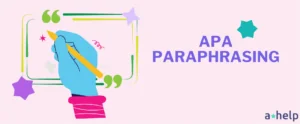
APA Paraphrasing

Why Is Paraphrasing Important?
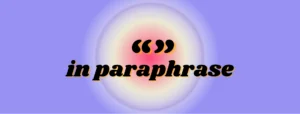
Do Paraphrases Need Quotation Marks
Remember Me
What is your profession ? Student Teacher Writer Other
Forgotten Password?
Username or Email

Citation Quick Guides and Style Manuals
- APA Style Quick Guide (7th Edition)
- APA Style Quick Guide (6th Edition)
- MLA Style Quick Guide (8th Edition)
- Chicago Manual of Style Quick Guide (17th Edition)
- Citing Maps
- What Do You Need to Cite?
- Avoiding Plagiarism
- Other Citation Styles (By Discipline)

In the Library
Online and Outreach Specialist

APA Printable Quick Guide
- APA Quick Guide (7th Edition)
APA 7th Video series
Research Management Software
- Zotero Zotero (pronounced "zoh-TAIR-oh") is a research management application that works with your Firefox, Chrome, or Safari browser to collect, manage, and cite research sources. Follow the link for more information on how to set up and use Zotero.
Paraphrasing
Paraphrasing: To restate an idea in your own words.
APA Style prefers that authors paraphrase ideas from sources rather than directly quoting from them. Paraphrasing allows you to connect the ideas in a source to the ideas in your paper more clearly and succinctly. It cuts down on wordiness and demonstrates your understanding of the source itself.
Although we regularly paraphrase our experiences in conversation, paraphrasing content from scholarly articles into your research paper can be a challenging exercise! This is because you are learning new content and a new academic communication style as your read.
Below are some tips from to help you successfully paraphrase the ideas of others:
- Closely read the section of the source you want to paraphrase. Read it more than once until you truly understand it.
- Note how this source connects to your thesis/paper topic. Ask yourself: Why do I want to use this source?
- Hide the source from view, so you can't see that section anymore.
- Imagine explaining the section to a friend or classmate. Write down what you would say.
- Compare your paraphrase to the source itself to make sure you have captured the idea, but not copied the author's words or phrasing.
- Revise your paraphrase, so that it's written in your own voice and it doesn't mimic the phrasing or sentence structure of the original source. If you do need to use a specific term from the original in your paraphrase, put it inside quotation marks.
- Cite the source!
Sources: Purdue OWL , University of Wisconsin-Madison Writing Center , Walden University Writing Center
Online Help Guides and APA Resources
- APA Style Blog (7th Edition) Run by the official APA Style team, this blog is an authoritative source for answers to APA questions. It also provides commentary, context, and announcements related to APA Style.
- APA Style Tutorial Detailed introduction to the the basics of APA Style created by the APA.
- Decolonizing APA Citations Indigenous oral teachings are more than a "personal communication". Created by Lorisia Macleod of the James Smith Cree Nation, this report provides detailed templates for citing Indigenous knowledge.
- Missing Reference Information Examples of how to cite a source when you are missing information about it, such as the author or date.
- Purdue OWL APA Guide Abbreviated guide to APA Style created by the Purdue Online Writing Lab.
- Reference Examples Reference examples for different types of sources including, TED Talks, PowerPoints, TikTok videos, and more.
- Sample Papers Sample student papers formatted in APA Style.
- << Previous: Home
- Next: APA Style Quick Guide (6th Edition) >>
- Last Updated: Jun 20, 2024 11:16 AM
- URL: https://libguides.wwu.edu/citation_style

Citation Style: APA 7th edition
- Citation help
- Free citation generators
- Journal, magazine & newspaper articles
- Other resource types
- Citing indirect / secondary sources
- APA Style Reference Examples This link opens in a new window
- Quoting, paraphrasing and signal phrases
- In-text citations
- Annotated bibliography
Quoting and Paraphrasing
Quoting Sources:
When you quote a source, you include the author's exact words in your text. Use "quotation marks" around the author's words. Include signal phrases and an in-text citation to show where the quote is from.
Paraphrasing Sources:
When you paraphrase a source, you restate the source's ideas in your own words and sentence structure. Select what is relevant to your topic, and restate only that. Changing only a few words is not sufficient in paraphrasing/ summarizing. Instead, you need to completely rephrase the author's ideas in your own words. You do not need to use quotation marks.
For more help on paraphrasing click here :
Always use in-text citations when you paraphrase or summarize, to let the reader know that the information comes from another source. Continue to use signal phrases as well.
Signal Phrases
Signal phrases let your reader know that you are quoting or summarizing from another source.
In the words of researchers Redelmeier and Tibshirani, " . . . "
As Matt Sundeen has noted, " . . . "
Patti Pena, mother of a child killed by a driver distracted by a cell phone, points out that " . . . "
" . . . " writes Christine Haughtney.
" . . . " claims wireless spokesperson Annette Jacobs.
Taken from the Bedford Handbook (583)
Verbs in Signal Phrases
| acknowledges adds admits agrees argues asserts believes claims | comments compares confirms contends declares denies disputes emphasizes | endorses grants illustrates implies insists notes observes points out | reasons refutes rejects reports responds suggests thinks writes |
- << Previous: APA Style Reference Examples
- Next: In-text citations >>
- Last Updated: May 13, 2024 1:04 PM
- Web address for this page:: https://libguides.reynolds.edu/apa
Find and fix writing mistakes instantly
- Check for unintentional plagiarism
- Get instant grammar and style suggestions

Paraphrasing in APA
If you’re taking a class in the social sciences, such as psychology, sociology, or political science, you’re probably using APA (American Psychological Association) format. One important use of formatting guidelines is to standardize the way you incorporate and cite sources in your papers.
Sources are incorporated into papers as quotations, summaries, or paraphrases. Paraphrasing is also called “indirect discourse” because instead of directly writing what the source says, you’re putting it in your own words. The source is represented indirectly, but still with proper citation.
Some people have the misconception that if they change the wording of a source, as we do in a paraphrase, they no longer must cite the source. This isn’t true; it’s always important to let readers know when you’re using ideas from a source. This lets readers see the depth of your research.
Let’s look at how to properly incorporate paraphrases using APA format.
Letting the reader know when a paraphrase starts
In a quotation, it is easy for a reader to tell when the quote begins and ends because the quote is enclosed in quotation marks. Paraphrases lack quotation marks, but it’s still important to show the readers when you’re shifting into material from a source. You don’t want readers to be confused about whether they’re reading your idea or an idea from a source.
Narrative citation
It’s important to organize your paraphrase so it’s clear where it begins and ends, so it’s not abruptly dropped in. Narrative citation involves working some amount of the citation information into the sentence that transitions into the paraphrase. This information is part of the signal phrase that lets the reader know that a source is coming. A narrative citations usually includes the following information:
- Last Name of the Author
- Year of Publication
- Single page — p. 1
- Page range — pp. 1-5
The first time you use the source, include the author’s full name. You may also want to include something about his or her credentials so it’s clear to the readers why this person is a relevant authority.
Narrative format:
Last Name of the Author (Year of Publication) other paraphrase text (Page number).
Narrative example:
Bryan Stevenson, author of Just Mercy (2014), explained how the traditional agriculture base of the Alabaman economy had to change as a result of several factors, including the migration of African Americans to other areas of the country in the 1940s (p. 24).
After the first mention of an author, you can switch to using just their last name. You can also use an appropriate pronoun if it would be clear to readers whom the pronoun refers to, such as if there are several paraphrases from the same author in one paragraph.
An appropriate verb is also part of the signal phrase. In the example above, that verb is “explained.” In APA format, these verbs are in simple past tense or past perfect tense.
Letting the reader know when a paraphrase ends
Just like with the beginning of a paraphrase, the end needs to be signaled to the reader in some way.
Parenthetical citation
Parenthetical citations go at the end of a quote or paraphrase. In APA format, the information in a parenthetical citation is the author’s last name, a comma, and the year of publication. If the author’s last name and the date were given at the beginning of the paraphrase, they do not have to be repeated at the end. A page number is optional for a paraphrase, but it is a good idea. Part of the reason for citations is to allow a reader to follow your research. If the source you are paraphrasing is long or complex, a page number would help the reader find the original material. Place a lowercase ‘p’ followed by a period and a space before the page number. If you’re paraphrasing material over more than one page, use two lowercase p’s followed by a period.
Parenthetical format:
Paraphrase text (Last Name of the Author, Year of Publication, Page number).
Stevenson (2014) explains that proximity allows us to see that people can’t be reduced to their worst actions (pp. 17-18).
Parenthetical example:
Proximity allows us to see that people can’t be reduced to their worst actions (Stevenson, 2014, pp. 17-18).
When there are no page numbers or listed authors
Of course, some sources, such as web pages, do not have page numbers. Sometimes a writer will cite the paragraph number. In this case, write ‘para’ followed by a period, a space and the paragraph number. If the paraphrase is over more than one paragraph, add an ‘s’. If the text is long enough that counting out the paragraphs would be unreasonable, you can include another identifying feature, like the chapter name or number.
Despite fanciful theories rarely based in fact, the National Oceanic and Atmospheric Administration (2019) has maintained that the natural environment is the main cause of vessel disappearances in the Bermuda Triangle (para. 3).
The parenthetical citation goes within the sentence, so the period is to the right of the parenthesis.
The information comes from an unpaginated source, so the paragraph number was used instead.
Notice also that in this example there is no person given as the author. Rather, the information is credited to the National Oceanic and Atmospheric Administration. Likewise, on the website where this information is found, no person is given as the author. The organization is considered the author. On the references page, the name of the organization will be in the author position.
Some organizations have well-known abbreviations. If that is the case, the first time you refer to an organization, use the full name in the citation but include the abbreviation immediately after in square brackets. For all further citations, you can just use the abbreviation. If you’re unsure whether an organization’s abbreviation is well-known, err on the side of clarity for the reader and use the full name.
Connection to the references page
A reader can take the information in an in-text citation and find the source on the references page. The references page provides the full citation. With this, a reader can easily find the text herself if she wants to read further. An in-text citation includes the author’s last name. This is the first piece of information on a references page citation, which makes it easy to match up the in-text citation to the right source.
Published October 29, 2020.
How useful was this post?
Click on a star to rate it!
We are sorry that this post was not useful for you!
Let us improve this post!
Tell us how we can improve this post?
- Citing Paraphrases and Summaries (APA)
How should a paraphrased passage be cited?
When paraphrasing a passage, it is essential to express the ideas of the author in your own original words; however, the author’s message and meaning should always be preserved.
Charges of plagiarism can be avoided by including the proper citation of the work you are drawing from in your paraphrase. The APA requires a paraphrase to include the author’s last name and the work’s year of publication, but also suggests that the page number of the original text be included.
Let’s look at an example of a cited paraphrase:
Original text: “A yellow flower is yellow because it reflects yellow light and absorbs other wavelengths. The red glass of a stained glass window is red because it transmits red light and absorbs other wavelengths. The process by which we perceive the colours of natural objects around us can therefore be described as a ‘subtractive’ process” (Pender, 1998, p. 14). [1]
Paraphrase: Pender explains that through subtractive process , humans see the color of objects based on the wavelengths of light that are absorbed by each object (Pender, 1998, p. 14). [1]
Note: The paraphrase maintains the ideas of the original passage while expressing the message in a new voice. The original author is also cited properly.
How should a summarized passage or work be cited?
When summarizing a passage or work from another writer, briefly outline in your own original words the major ideas presented in the source material. As brevity is the key feature of a summary, it is essential to express the main concepts of the original passage in as concise a manner as possible. Consider using a summary—rather than a short or block quotation—when preserving the original wording of the source material is not necessary for the reader to understand the ideas under discussion.
Let’s look at an example of a cited summary:
Original text: “In their everyday life, people generally assume that they see the world around them the way it really is. When camping in Colorado, hikers believe they see the horizon as dotted with snow-covered mountaintops. When laying on the beach in North Carolina, sunbathers believe they see pelicans flying above the breaking waves. And these people would nearly always be right. Indeed, it is difficult to imagine not believing that the sights and sounds delivered to conscious awareness by perceptual systems are accurate renderings of the outside world. It would be difficult to know how to act if one could not trust one’s senses to accurately report what the world outside is like” (Balcetis, 2010, p. 77). [2]
Summary: In Social Psychology of Visual Perception , Balcetis (2010) argues that because humans rely on the sensory information received from their body, they form preconceived beliefs about their surroundings that manifest as imaginary visual occurrences (p. 77). [2]
Note: The summary maintains the ideas of the original passage while concisely expressing its main concepts. The original author is also cited properly.
How should multiple sources be cited in a single parenthetical reference?
If multiple works need to be cited in the same set of parentheses, simply arrange them in alphabetical order by the author’s last names, or the order in which they would be listed in the References page. Use a semicolon to separate each work from the next one.
Let’s look at an example of multiple authors being cited:
In the past thirty years, Parkinson’s disease has been written about extensively by recognized figures in the field (Dorros, 1989; Duvoisin, 1991; Hauser & Zesiewicz, 1996). [3][4][5]
Note: This example includes the in-text citations of three works arranged in alphabetical order by authors’ names, separated by semi-colons, and enclosed in parentheses.
- Formatting In-text Citations (APA)
[1] Pender, K. (1998). Digital colour in graphic design . Burlington, VT: Elsevier Science & Technology.
[2] Balcetis, E. (2010). Social psychology of visual perception . Hoboken, NJ: Taylor & Francis.
[3] Dorros, S. (1989). Parkinson’s: A patient’s view . Cabin John, MD: Seven Locks Press.
[4] Duvoisin, R. C. (1991). Parkinson’s disease: A guide for patient and family . New York, NY: Raven Press.
[5] Hauser, R. A., & Zesiewicz, T. A. (1996). Parkinson’s disease: Questions and answers . Coral Springs, FL: Merit.
- Citing Paraphrases and Summaries (APA). Provided by : Writing Commons. Located at : http://writingcommons.org/index.php?option=com_content&view=article&id=694:citing-paraphrases-and-summaries-apa&catid=184&Itemid=297 . License : CC BY-NC-ND: Attribution-NonCommercial-NoDerivatives
- Table of Contents
Instructor Resources (Access Requires Login)
- Overview of Instructor Resources
An Overview of the Writing Process
- Introduction to the Writing Process
- Introduction to Writing
- Your Role as a Learner
- What is an Essay?
- Reading to Write
- Defining the Writing Process
- Videos: Prewriting Techniques
- Thesis Statements
- Organizing an Essay
- Creating Paragraphs
- Conclusions
- Editing and Proofreading
- Matters of Grammar, Mechanics, and Style
- Peer Review Checklist
- Comparative Chart of Writing Strategies
Using Sources
- Quoting, Paraphrasing, and Avoiding Plagiarism
- Formatting the Works Cited Page (MLA)
- APA Citation Style, 6th edition: General Style Guidelines
Definition Essay
- Definitional Argument Essay
- How to Write a Definition Essay
- Critical Thinking
- Video: Thesis Explained
- Effective Thesis Statements
- Student Sample: Definition Essay
Narrative Essay
- Introduction to Narrative Essay
- Student Sample: Narrative Essay
- "Shooting an Elephant" by George Orwell
- "Sixty-nine Cents" by Gary Shteyngart
- Video: The Danger of a Single Story
- How to Write an Annotation
- How to Write a Summary
- Writing for Success: Narration
Illustration/Example Essay
- Introduction to Illustration/Example Essay
- "She's Your Basic L.O.L. in N.A.D" by Perri Klass
- "April & Paris" by David Sedaris
- Writing for Success: Illustration/Example
- Student Sample: Illustration/Example Essay
Compare/Contrast Essay
- Introduction to Compare/Contrast Essay
- "Disability" by Nancy Mairs
- "Friending, Ancient or Otherwise" by Alex Wright
- "A South African Storm" by Allison Howard
- Writing for Success: Compare/Contrast
- Student Sample: Compare/Contrast Essay
Cause-and-Effect Essay
- Introduction to Cause-and-Effect Essay
- "Cultural Baggage" by Barbara Ehrenreich
- "Women in Science" by K.C. Cole
- Writing for Success: Cause and Effect
- Student Sample: Cause-and-Effect Essay
Argument Essay
- Introduction to Argument Essay
- Rogerian Argument
- "The Case Against Torture," by Alisa Soloman
- "The Case for Torture" by Michael Levin
- How to Write a Summary by Paraphrasing Source Material
- Writing for Success: Argument
- Student Sample: Argument Essay
- Grammar/Mechanics Mini-lessons
- Mini-lesson: Subjects and Verbs, Irregular Verbs, Subject Verb Agreement
- Mini-lesson: Sentence Types
- Mini-lesson: Fragments I
- Mini-lesson: Run-ons and Comma Splices I
- Mini-lesson: Comma Usage
- Mini-lesson: Parallelism
- Mini-lesson: The Apostrophe
- Mini-lesson: Capital Letters
- Grammar Practice - Interactive Quizzes
- De Copia - Demonstration of the Variety of Language
- Style Exercise: Voice

APA Citation and Paper Formatting Guide (APA 7th Edition): Paraphrasing
- Books & ebooks
- Journal Articles (academic, scholarly, peer-reviewed)
- Magazine Articles
- Newspaper Articles
- Encyclopedias, Dictionaries, & Wikipedia (Reference Works)
- Films, Videos, & YouTube
- Music & Podcasts (Audio Works)
- Art, Photography, & Images (Visual Works)
- Social Media
- Class Notes, Class Lectures and Presentations (PowerPoint)
- Personal Communication (Interviews, Emails)
- Works Quoted in Another Source
- When Information Is Missing
- Can't Find What You're Looking For?
Paraphrasing
- Sample Papers and Reference Lists
Additional Resources
In-text basics (paraphrasing).
When using APA format, follow the author-date method of in-text citation. This means that the author's last name and the year of publication for the source should appear in the text, like, for example, (Jones, 1998). One complete reference for each source should appear in the reference list at the end of the paper.
If you are referring to an idea from another work but NOT directly quoting the material (i.e. paraphrasing ), or making reference to an entire book, article or other work, you only have to make reference to the author and year of publication and not the page number in your in-text reference. APA guidelines, however, do encourage including a page range for a summary or paraphrase when it will help the reader find the information in a longer work.
Regardless of how they are referenced, all sources that are cited in the text must appear in the reference list at the end of the paper.
Source: Purdue OWL
When you write information from a source in your own words, cite the source by adding an in-text citation at the end of the paraphrased portion as follows:
Mother-infant attachment became a leading topic of developmental research following the publication of John Bowlby's studies (Hunt, 1993).
If you refer to the author's name in a sentence you do not have to include the name again as part of your in-text citation, instead include the year of publication following his/her name:
Hunt (1993) noted that mother-infant attachment became a leading topic of developmental research after the publication of John Bowlby's studies.
Paraphrasing Examples
Original Source
Homeless individuals commonly come from families who are riddled with problems and marital disharmony, and are alienated from their parents. They have often been physically and even sexually abused, have relocated frequently, and many of them may be asked to leave home or are actually thrown out, or alternatively are placed in group homes or in foster care. They often have no one to care for them and no one knows them intimately.
Source from:
Rokach, A. (2005). The causes of loneliness in homeless youth. The Journal of Psychology , 139, 469-480. Retrieved from Academic Search Premier database.
Example: Incorrect Paraphrasing
The homeless come from families with problems. Frequently, they have been physically or sexually abused, or have lived in group homes. Usually no one cares for them or knows them intimately (Rokach, 2005).
Note : In this incorrect example the writing is too similar to the original source. The student only changed or removed a few words and has not phrased the ideas in a new way.
Example: Correct Paraphrasing
Many homeless experience isolation in part due to suffering from abuse or neglect during their childhood (Rokach, 2005).
Note : The example keeps the idea of the original writing but phrases it in a new way.
Three or More Authors/Editors (In-text citations)
| (First Author's Last Name et al., Year of Publication) Example: (FitzGerald et al., 2020) | (First Author's Last Name et al., Year of Publication, p. Page number of quotation) Example (FitzGerald et al., 2020, p. 405) |
No Author and/or No Date
No Known Author:
Where you'd normally put the author's last name, instead use the first one, two, or three words from the title. Don't count initial articles like "A", "An" or "The". You should provide enough words to make it clear which work you're referring to from your References List.
If the title in the References list is in italics, italicize the words from the title in the in-text citation.
If you are citing an article, a chapter of a book or a page from a website, put the words in double quotation marks.
( Cell Biology , 2012)
("Nursing," 2011)
No Known Date of Publication :
Where you'd normally put the year of publication, instead use the letters "n.d.".
(Smith, n.d.)
More Than One Author/Editor
Two Authors or Editors
Provide each author's last name and the year of publication each time you cite the work in-text.
Three or More Authors or Editors
Provide the first author's last name followed by "et al.," and the year of publication every time you cite the work in-text.
Have a question about paraphrasing or in-text citations that isn't answered on this page? Check out these sites for more detailed information:
- Paraphrasing (American Psychological Association)
- In-Text Citations (American Psychological Association)
- APA In-Text Citations (Excelsior OWL)
- << Previous: Quoting
- Next: Sample Papers and Reference Lists >>
- Last Updated: Sep 5, 2023 12:04 PM
- URL: https://lib.lavc.edu/apa

- Free Tools for Students
- APA Citation Generator
Free APA Citation Generator
Generate citations in APA format quickly and automatically, with MyBib!

🤔 What is an APA Citation Generator?
An APA citation generator is a software tool that will automatically format academic citations in the American Psychological Association (APA) style.
It will usually request vital details about a source -- like the authors, title, and publish date -- and will output these details with the correct punctuation and layout required by the official APA style guide.
Formatted citations created by a generator can be copied into the bibliography of an academic paper as a way to give credit to the sources referenced in the main body of the paper.
👩🎓 Who uses an APA Citation Generator?
College-level and post-graduate students are most likely to use an APA citation generator, because APA style is the most favored style at these learning levels. Before college, in middle and high school, MLA style is more likely to be used. In other parts of the world styles such as Harvard (UK and Australia) and DIN 1505 (Europe) are used more often.
🙌 Why should I use a Citation Generator?
Like almost every other citation style, APA style can be cryptic and hard to understand when formatting citations. Citations can take an unreasonable amount of time to format manually, and it is easy to accidentally include errors. By using a citation generator to do this work you will:
- Save a considerable amount of time
- Ensure that your citations are consistent and formatted correctly
- Be rewarded with a higher grade
In academia, bibliographies are graded on their accuracy against the official APA rulebook, so it is important for students to ensure their citations are formatted correctly. Special attention should also be given to ensure the entire document (including main body) is structured according to the APA guidelines. Our complete APA format guide has everything you need know to make sure you get it right (including examples and diagrams).
⚙️ How do I use MyBib's APA Citation Generator?
Our APA generator was built with a focus on simplicity and speed. To generate a formatted reference list or bibliography just follow these steps:
- Start by searching for the source you want to cite in the search box at the top of the page.
- MyBib will automatically locate all the required information. If any is missing you can add it yourself.
- Your citation will be generated correctly with the information provided and added to your bibliography.
- Repeat for each citation, then download the formatted list and append it to the end of your paper.
MyBib supports the following for APA style:
| ⚙️ Styles | APA 6 & APA 7 |
|---|---|
| 📚 Sources | Websites, books, journals, newspapers |
| 🔎 Autocite | Yes |
| 📥 Download to | Microsoft Word, Google Docs |

Daniel is a qualified librarian, former teacher, and citation expert. He has been contributing to MyBib since 2018.
VCU Writes: A Student’s Guide to Research and Writing
Focused inquiry, apa quoting, paraphrasing and summarizing.
An essential skill in writing is the ability to ethically and accurately share the ideas of others. Quotations, paraphrases and summaries are all methods of including research in your writing or presentations. Here is a quick overview of the difference between quoting, paraphrasing and summarizing:
- What it is: Using the exact words of your source; must be placed within quotation marks.
- When to use it: Specific terminology, powerful phrases.
- Example: McMillan Cottom (2021) explains that “Reading around a subject is about going beyond the object of study to unpack, examine, or pick apart what the person or the object of study represents” (1).
PARAPHRASING
- What it is: Putting another’s ideas into your own words.
- When to use it: To clarify a passage, to avoid over-quoting.
- Example: McMillan Cottom (2021) contends that, in addition to reading about a subject itself, we also need to read about the ideas and concepts that are ingrained in a subject in order to truly understand its deeper meaning (1).
SUMMARIZING
- What it is: Putting a larger main idea into your words.
- When to use it: Overview of a topic, main point/idea.
- Example: In McMillan Cottom’s (2021) article, “Sleep Around Before You Marry an Argument,” she describes the process of preparing to write about a subject and develop an argument. For her, the first and most important stage in this process is reading; however, she isn’t focused on simply reading everything ever written on a topic, but “reading around a subject.” In her view, the end goal is not just to compile facts, but to develop a thorough, but interesting final product that will connect with your audience. (1)
McMillan Cottom, T. (2021, March 8). “Sleep around before you marry an argument.” Essaying , Substack. https://tressie.substack.com/p/sleep-around-before-you-marry-an?utm_source=url
Note: This page reflects the latest version of the APA Publication Manual (APA 7), which released in October 2019.
General Guidelines
While you are still gaining experience and confidence in writing, there is often a temptation to rely heavily on the words and ideas of others. You might think, “How can I possibly say it as well as the expert?” or “How will anyone believe me unless I add in exhaustive research?” However, having confidence in your own ideas is one of the hallmarks of a more experienced writer, and this means that when incorporating the ideas of others, we should not allow them to “take over” our own ideas.
In addition, sometimes it is better to paraphrase or summarize an idea to keep it brief, rather than having an excessively long quotation. (See below for more info on both paraphrasing and summarizing ideas.)
That said, there are a number of reasons why we might want to quote the ideas of others. Here are some of the most common:
- When wording is very distinctive so you cannot paraphrase it adequately;
- When you are using a definition or explaining something very technical;
- When it is important for debaters of an issue to explain their positions in their own words (especially if you have a differing viewpoint);
- When the words of an authority will lend weight to your argument;
- When the language of a source is the topic of your discussion (as in an interpretation).
In certain instances, you do not need to cite information. This is called the “common knowledge rule.” If a fact is widely and generally known (e.g., the sun rises in the east and sets in the west), you do not need to cite. Similarly, familiar sayings or oft-repeated quotations (e.g., “a penny saved is a penny earned”) do not need citations.
Common knowledge can in some cases be audience-specific; research scientists writing to their peers can assume a different level of common knowledge on their subject than when writing to a younger, less educated audience, for example. If you are ever in doubt as to whether you should cite a piece of information, ask your professor or a Writing Center consultant.
Trying to balance your ideas and those of your sources takes a bit of skill and finesse. The goal is to make the ideas (both yours and those of your sources) feel and look like a conversation—a mutual exchange of voices and ideas that helps you and your audience work out your reasoning on a topic. (You can read more about this idea of academic conversations here .) Sometimes, in the process of trying to incorporate the ideas of others, things fall a bit short of the ideal. Here are some common missteps that can lead to your writing seeming less polished:
- Over-using one source: If you find yourself repeatedly citing the same source again and again in your writing, it will begin to seem as if you are merely repackaging the other author’s ideas, rather than presenting your own. It also gives the appearance that your ideas are one-sided, due to the lack of a diversity of voices in the conversation.
- Having more source material than your own original ideas*: Try color-coding your writing. Highlight each instance where you are quoting, paraphrasing or summarizing a source. What’s left? Is your essay a rainbow of colors, with little else? Or are the majority of ideas/sentences yours, with a few well-chosen instances of source material? Aim for the latter; otherwise, it will seem like you are just “reporting out” on all the research you have gathered, rather than developing your own thinking on a subject.
- Does every aspect of this passage relate to my own paragraph ideas?
- Can I cut out a section of this quotation to emphasize the points that are most relevant? (If yes, see below on proper formatting when you eliminate a portion of the quoted material.)
- Would it be easier/better/more concise to paraphrase this idea? (If yes, see below on how to correctly and incorrectly paraphrase.)
- Dropping in a random quote or source reference: Ideas without context are always confusing, whether they are yours or someone else’s. Make sure you provide adequate context and make connections between your ideas and those of your sources.
- Signal phrase (a few words that introduce the author and year of publication for the source; this might also include credentials of the author and/or title of work);
- Quoted, paraphrased or summarized material, followed by a parenthetical citation;
- Your own thinking that expands upon the ideas from the source material, and connects it back to your larger point.
For more on how to effectively incorporate evidence into your writing or presentation, see the handout “What Is Evidence?” here on VCU Writes.
*NOTE : This goal is more applicable to some writing situations than others. In a lab report or literature review, for example, the majority of your discussion might include restating/sharing research. Always confirm with your instructor if you are not sure what the appropriate balance of source material should be for your specific writing situation.
When quoting material from a source, wording and punctuation should be reproduced exactly as it is in the original. If you need to alter the quotation in any way, you must indicate this through punctuation or added material. Otherwise, you will be misrepresenting the ideas of others.
When paraphrasing or summarizing source info, you should still use quotation marks and cite any distinctive wording that you kept from the original.
See below for examples of how to correctly alter quotations.
Direct Quotation of Sources
A . Quotations that are fewer than four lines should be included in the text and enclosed in quotation marks. If you introduce the quotation in a signal phrase with the author’s full name and year of publication (or source title, if the author’s name is not provided), include “p.” and the page number in parentheses after the end of the quotation and before the period. It is not necessary to repeat the name or publication in the parenthetical citation :
On the efficacy and importance of religion, David Hume (2005) asserts , “The life of man is of no greater importance to the universe than that of an oyster” (p. 94) .
B . If you do not introduce the quotation with the author’s full name and publication date (or source title, if the author’s name is not provided), include the author’s last name, publication date, and page number (using “p.” before the number) in parentheses after the end of the quotation and before the period. Use commas to separate each piece of information in the parenthetical citation:
When considering the efficacy and importance of religion, one must understand that “the life of man is of no greater importance to the universe than that of an oyster” (Hume, 2005, p. 94) .
C . If the quotation appears mid-sentence , end the passage with quotation marks, cite the source in parentheses immediately after quotation marks, and finish the sentence:
Based on the findings, Sommerfeldt (2011) argued that “the normative role of public relations in democracy is best perceived as creating the social capital that facilitates access to spheres of public discussion” (p. 664) , challenging dominant notions of democratic discourse.
Quotations that are more than four lines should be displayed in block quotation format . This is an indented passage that does not require quotation marks (the indent serves in place of quotation marks):
In McLuhan’s compass for the voyage to a world of electric words, Terrence Gordon (2011) explains how Marshall McLuhan wrote The gutenberg galaxy :
In a letter written to his in-laws on Christmas Day 1960, Marshall McLuhan mentioned that he had drafted a book in less than a month. Of all his publications, The Gutenberg Galaxy (henceforth GG), so explosive on the page, had the tidiest beginnings. The manuscript flowed from McLuhan’s pen until he had written 399 pages. There he stopped, so that the total of the carefully numbered foolscap sheets would be divisible by three. (p. vii)
Gordon goes on to explain that the number three was a symbol of order for McLuhan throughout his life.
Note that the period at the end of the block quotation is placed at the end of the sentence, rather than after the parenthetical citation. After the quotation is completed, continue your paragraph on the left margin (i.e., don’t indent as if it were a new paragraph).
If the quotation includes an alternate spelling (i.e., British English) or an error in grammar, punctuation, or spelling, write the word “sic” in brackets directly after the alternate spelling or error inside the quotation :
“VCU is well known for it’s [sic] diversity” (Jones, 2017, p. 43).
This lets the reader know that it is the original writer’s spelling or error.
A . Though direct quotations must be accurate, the first letter of the first word in the quotation may be changed either as uppercase or lowercase to match the flow of your sentence. Additionally, the punctuation mark ending a sentence may also be changed if necessary for appropriate syntax.
B . It is sometimes important to insert material when it will help the reader understand the quotation. When inserting material, enclose the insert in brackets:
Original quotation :
“By programming a variety of Twitter bots to respond to racist abuse against black users, he showed that a simple one-tweet rebuke can actually reduce online racism” (Yong, 2016, para 3).
Revised quotation with brackets :
“By programming a variety of Twitter bots to respond to racist abuse against black users, [Kevin Munger] showed that a simple one-tweet rebuke can actually reduce online racism” (Yong, 2016, para 3).
C . When adding emphasis to a section of a quotation, italicize the specific word(s) and write “ emphasis added ” in brackets (e.g.,):
Original quotation:
“By programming a variety of Twitter bots to respond to racist abuse against black users, he showed that a simple one-tweet rebuke can actually reduce online racism” (Yong, 2016, para. 3).
Revised quotation with emphasis :
“By programming a variety of Twitter bots to respond to racist abuse against black users, he showed that a simple one-tweet rebuke [emphasis added] can actually reduce online racism” (Yong, 2016, para. 3).
Note : If words were already italicized in the quoted material, you do not need to include the “emphasis added” designation. It is assumed that all formatting is original to the quotation unless you indicate otherwise.
It is often useful to omit material when you do not need all words or sentences included in the passage you are citing. If you omit material, use three spaced periods (. . .) within a sentence (the three periods are called an ellipsis) to indicate that you have omitted material from the original source:
Ariel Levy notes that “in the decades since the McKennas’ odyssey, the drug . . . has become increasingly popular in the United States” (34).
If you omit material after the end of a sentence, use four spaced periods (. . . .) . This is a period, followed by an ellipsis.
Paraphrasing source material
When a writer uses another person’s idea but puts it in their own words, the writer is paraphrasing . We use paraphrasing when we wish to preserve the original ideas in their entirety (as opposed to summarizing the main points). Some reasons a writer might choose to do this include preserving the flow of their writing, or if quoting the material directly would take up too much space.
It is important to remember that just as with quotations, paraphrased material requires an in-text citation to give credit to the original author .
When paraphrasing or referencing an idea from another source, make sure that you provide enough information for the reader to easily locate the passage from the source you reference (for example, the page number or the paragraph number).
Example paraphrase :
Original passage : “Reading around a subject is about going beyond the object of study to unpack, examine, or pick apart what the person or the object of study represents” (McMillan Cottom, 2021, p. 1).
Unacceptable paraphrase : It’s important to read around the subject that we are studying by examining what that subject represents.
- Issue 1: Certain words from the original are simply moved around.
- Issue 2: Certain words are only replaced with synonyms or similar words.
- Issue 3: The sentence structure has remained the same.
- Issue 4: The source citation is missing.
Acceptable Paraphrase : McMillan Cottom (2021) contends that, in addition to reading about a subject itself, we also need to read about the ideas and concepts that are ingrained in a subject in order to truly understand its deeper meaning (p. 1).
McMillan Cottom, T. (2021, March 8). “Sleep around before you marry an argument.” Essaying, Substack. https://tressie.substack.com/p/sleep-around-before-you-marry-an?utm_source=url
Many writers are reluctant to paraphrase because they worry about making mistakes and unintentionally plagiarizing ideas in their writing. This is a valid concern, but with practice this skill can be developed just like any other. Learning to paraphrase effectively can demonstrate a deeper understanding and command of the ideas you are discussing, and aid in the flow of ideas in your essay or presentation. That said, there are some common mistakes that should be avoided:
- When paraphrasing, make sure that you don’t copy the same pattern of wording as the original sentence or passage . This sometimes happens when a writer tries to just swap out a few words, but keeps the structure of the sentence the same or very similar.
- Likewise, avoid using the same or very similar wording as the original . If your paraphrase includes a word or phrase borrowed from the original, make sure to put that portion in quotation marks.
- As noted above, paraphrases require citations, just like direct quotations. Always include a signal phrase and parenthetical citation to indicate that the info you are sharing is not your own. This is especially important in paraphrasing to make a clear distinction between the writer’s own ideas and the source info. Also, citing your source makes sure that you provide enough information for the reader to easily locate the passage from the source you reference.
To make sure that you don’t fall prey to the above mistakes, read the passage you wish to paraphrase and then put it aside. Without looking at it, try to think about how you can say it in your own words, and write it down. Make sure you aren’t including your own ideas—just try to capture the essence of the original in as clear and straightforward a manner as possible.
Summarizing source material
As explained at the top of this page, a summary is when a writer wants to provide a brief overview of a larger idea. This is distinct from a paraphrase, which usually focuses on a single sentence or paragraph. A writer can summarize an entire essay, a section of an article, or the overall main idea of a composition. While summarizing is perhaps not used as frequently as quoting or paraphrasing in academic writing, it can be an effective critical thinking and reading tool. In fact, your instructor may ask you to do a summary as part of your reading and research gathering to demonstrate your understanding of the material. In most academic writing, summaries should be used sparingly, but can be an efficient way to provide additional context to the intended audience.
It is important to remember that just as with quotations and paraphrases, summarized material requires an in-text citation to give credit to the original author .
When summarizing an idea from another source, make sure that you provide enough information for the reader to easily locate the passage from the source you reference (for example, the page number or the paragraph number).
Example summary :
The following summary focuses on an online article written by Tressie McMillan Cottom, which you can read in full here .
In Tressie McMillan Cottom’s (2021) article, “Sleep Around Before You Marry an Argument,” she describes the process of preparing to write about a subject and develop an argument. For her, the first and most important stage in this process is reading; however, she isn’t focused on simply reading everything ever written on a topic, but “reading around the subject.” In her view, the end goal is not just to compile facts, but to develop a thorough, but interesting final product that will connect with your audience. (p. 1)
There are some common mistakes that should be avoided when summarizing a source:
- Providing too much detail : While a summary is by its nature longer than a paraphrase, too much detail means that you are getting a bit “in the weeds” with your writing. A summary should be focused on the big ideas of a piece of writing, rather than the individual sections or minor points. A good summary should be much shorter than the original; in most cases, a full paragraph will be more than enough.
- Using the same or very similar wording for part of the summary : Just as with paraphrasing, you want to avoid words, phrases, or patterns of wording from the original source. Stick to your own wording/ideas; if your summary does include a word or phrase borrowed from the original, make sure to put that portion in quotation marks.
- Not providing a citation : As with paraphrases and quotations, summaries also require citations. Always include a signal phrase and parenthetical citation to indicate that the ideas you are summarizing are not your own. This is especially important in summarizing to make a clear distinction between your own ideas and the source info. Also, citing your source makes sure that you provide enough information for the reader to easily locate the source you reference.
To make sure that you don’t fall prey to the above mistakes, read the item you wish to summarize and then put it aside. Without looking at it, try to think about how you would explain the main ideas from the source to someone else in your own words, and write that down. Make sure you don’t add your own analysis or opinion—just try to capture the essence of the original in as clear and straightforward a manner as possible.
Search results
Mailing list.
International Congress on Medieval Studies
The Medieval Institute at Western Michigan University maintains a mailing list of those interested in its programs, including the International Congress on Medieval Studies. Update Your Contact Information Please let us know if you change your address or you would like to be added to the mailing list . Please keep in mind that all U.S. postal addresses include either a street address or a P.O.
https://wmich.edu/medievalcongress/mailing-list
Suggested Tools List
Morean Center for Clay at WMU
Standard Pottery Tool Kit Inexpensive Graphite Pencils (no lead) Old Bath Towel (for wiping hands, larger than a dish or wash cloth) Old Metal Fork (great for hand building projects) Inexpensive Kids Craft Paint Brush Pack (great for decoration) Sketchbook (don’t forget a pen or pencil for drawing a
https://wmich.edu/morean/tool
Medieval Institute
The Medieval Institute at Western Michigan University maintains a mailing list of those interested in its programs, including the International Congress on Medieval Studies . Updating your information Please let us know if you change your address or you would like to be added to the mailing list . Please keep in mind that all U.S. postal addresses include either a street address or a P.O.
https://wmich.edu/medieval/mailing-list
Data Sources Listed Alphabetically
AFDB Socio Economic Database Afrobarometer AidData Armed Conflict Location & Event Data Project (ACLED) Avian Influenza, CDC Banco de Mexico Bank for International Settlements Triennial Survey CIA World Factbook Climate Data Online, NCEI Coronavirus (COVID-19) Coronavirus (COVID-19), CDC Coronavirus
https://wmich.edu/economics/global-data-center/alphabetical
Counselor Mailing List
Join our email list for updates Guidance and career counselors are important partners in the process of selecting a higher education path for their students. Occasionally, we have updates on the admissions process, procedures or have other details to share with you. We encourage you to join our mailing list to receive communication from us.
https://wmich.edu/admissions/counselors/mailing-list
Dean's Wish List
Lee Honors College
Listed below are the current funding needs to support innovative programming and unique educational opportunities within the Lee Honors College at Western Michigan University. To make a gift securely online, please visit wmualumni.org . Dean's discretionary fund : This fund provides support for special projects, unmet scholarship needs and innovative new initiatives under the direction of the dean.
https://wmich.edu/honors/giving/wishlist
Summer Camp Listing
Precollege Programming
General questions about this web page can be directed to the Office of PreCollege Programming at [email protected] or (269) 387-2773. To see the list of available WMU summer camps, check out the summer camp page . Camp Category Enter a category for the camp. Example categories are sports, writing, aviation, science, entrepreneurship, art, etc.
https://wmich.edu/precollege/summer/camps
University Recreation
To contact one of the clubs for more information, click on the "circle i" that is located on the bottom right corner of each card. You can reach out directly to that person with any questions. Disclaimer: The views, opinions and statements of individual sports clubs and information that appear on th
https://wmich.edu/rec/sportsclubs/clubcontacts
Southwestern Michigan Vocal Festival Music List
Irving S. Gilmore School of Music
Using photocopied music for this festival is forbidden with the exception of works found in public domain and provided on this page. Each student is expected to have an individual copy of each selection. Festival Chorus selections Johann Sebastian Bach – Sicut Locutus Est from Magnificat, BWV 243 [F
https://wmich.edu/music/events/festivals/swmvf/music
Mailing List Updates
Please add me to or update my information for the Medieval Institute mailing list ! Name * Street Address * Further Address Information (if needed) City * State/Province (if applicable) Postal Code (if applicable) Country * Preferred Email * Leave this field blank Submit
https://wmich.edu/medievalcongress/mailing-update
Pardon Our Interruption
As you were browsing something about your browser made us think you were a bot. There are a few reasons this might happen:
- You've disabled JavaScript in your web browser.
- You're a power user moving through this website with super-human speed.
- You've disabled cookies in your web browser.
- A third-party browser plugin, such as Ghostery or NoScript, is preventing JavaScript from running. Additional information is available in this support article .
To regain access, please make sure that cookies and JavaScript are enabled before reloading the page.

Harvard Style
- Position of the citation
- Secondary Referencing
- Date of Publication
- Page numbers
- Paraphrasing and Summarising
- Examples of References in Harvard style
- Quick A-Z Examples of References
- Citation Tools and Software

There are many tools available to create references for you automatically. Citing and organising your materials can be made simpler with the help of these tools and you can choose from a variety of citation formats.
Reference Management Software
Reference management software enables you to:
- collect references
- store references and notes
- organise references
- format references in a required referencing style to create a Reference list
- insert in-text citations into a document as you type. This will also generate a reference list or bibliography at the end of your document, based on those citations.
When writing the literature review phase of your thesis or article, having software to make bibliographies and add in-text citations will make the process much simpler and free up your time to work on other research-related tasks. In addition, you can change the citation style in seconds in your document which is convenient for different publishing requirements.
Examples of different packages are:
|
is the online, cloud based free version to store all your references and ATU library provides full support, library guides and training on this for individuals and groups. We have access to the expanded free version of EndNote Online through our subscription to Clarivate's and users are encouraged to log into this resource to access EndNote Online.
EndNote Online allows you to:
Along with the over 4800 citation styles available with EndNote Online, ATU library has developed a customised style template for use with Harvard ( ). Check out our for more details. | |
|
Zotero is a free citation tool that helps store and format bibliographic information. Zotero allows you to easily save citations that you find online, share your citations with others, and create bibliographies. You can use it online and download free software for your computer.
More information on Zotero can be found on their website at and in the ATU guide below.
| |
|
|
Mendeley is a free, easy to use application to help collect, organise, cite and share references. Features of Mendeley include:
More information on Mendeley can be found on their website at
|
Other Citation and Referencing Tools
| Cite Them Right is an online platform designed to advise students on how to reference correctly across eight referencing styles. It is based on the book of the same name in its 12th edition, by Richard Pears and Graham Shields.
There are examples to copy and a ' ' box so you can build your reference on screen and paste it into your assignment in the Reference list.
ATU Library has an institutional subscription to this service making it freely available to all our staff and students in all campuses. | |
|
| Microsoft Word comes with a very useful tool to aid you in referencing various sources of information correctly. It allows you to:
This will be done based on the reference information you provide for the document. You do this by using the ‘References’ tab on its toolbar. |
| MyBib.com is a free bibliography and citation generator that makes references for you to copy straight into your academic assignments in the Reference List.
MyBib can format webpages, books, journals, PDFs, and 30 other sources in over 9,000 different citation styles, including APA 7, Chicago, Harvard and MLA 9. This includes the Cite them Right 12 edition Harvard style which ATU library supports.
You can set up a free account or just use it to create a one-off Reference list. You can copy your generated citations directly into your assignment, or save them to your bibliography for later. You can export them into other citation managers like Zotero or Mendeley, print them directly, or store them in your Google Drive.
Special features:
|
ATU Referencing Tool Guides

- << Previous: Tables
- Next: Contact Us >>
- Last Updated: Jul 4, 2024 9:31 AM
- URL: https://atlantictu.libguides.com/harvard
QuillBot AI Review: Everything You Need to Know (2024)
Artificial intelligence (AI) is evolving quickly, and new AI tools and platforms are constantly appearing. In an era where clear, concise writing is highly coveted, AI writing tools are becoming increasingly crucial. One such impressive technology is QuillBot AI . Starting as a simple paraphrasing tool, QuillBot has become a robust AI writing assistant that symbolizes a significant stride in AI content optimization. This review thoroughly explores QuillBot AI, focusing on its key features, pricing structure, and strengths and weaknesses.
- 1 What is QuillBot AI?
- 2 How Quillbot AI Works
- 3.1 1. The Paraphraser
- 3.2 2. The Grammar Checker
- 3.3 3. Summarizer
- 3.4 4. Citation Generator
- 3.5 5. QuillBot Plagiarism Checker
- 3.6 6. The Translator
- 3.7 7. Quillbot Extensions
- 4 QuillBot AI Pricing and Plans Review
- 5.1 Pros of Using QuillBot AI
- 5.2 Cons of Using QuillBot AI
- 6 How QuillBot Compares to Other Similar Tools
- 7 Should You Use QuillBot? (The Verdict)
- 8 Frequently Asked Questions (FAQs)
What is QuillBot AI?

QuillBot AI is a leading AI writing companion and paraphrasing software designed to help anyone elevate the quality of their writing. At its core, it functions as one of the best AI rewriter tools to edit, rephrase, and enhance content like a professional.
It presents various features, including grammar checking, plagiarism detection, and content summarization. As such, QuillBot AI delivers substantial benefits for academics, essayists, and writers. Creating high-quality professional content can be time-consuming, and Quillbot streamlines the process using AI to improve your writing quickly, offering real-time suggestions and one-click solutions. Plus, it is an all-in-one solution that replaces the need to invest in multiple tools, making it cost-effective.
The versatility of the software caters to a diverse audience. While students can utilize its various writing tools, professional writers can efficiently collaborate and summarize lengthy text. If you want to improve your writing process, whether writing an email, an essay, or a long-form blog article, you will find Quillbot AI to be a valuable addition to your writing toolkit. It can revolutionize your writing process to produce surprising results.
How Quillbot AI Works
You can access QuillBot by visiting their online platform on their website . You don’t need to create an account; you can use a free version of QuillBot with limitations. Once you are there, you will see the available tools in the left sidebar. Click any of the tools to launch the user interface for each.
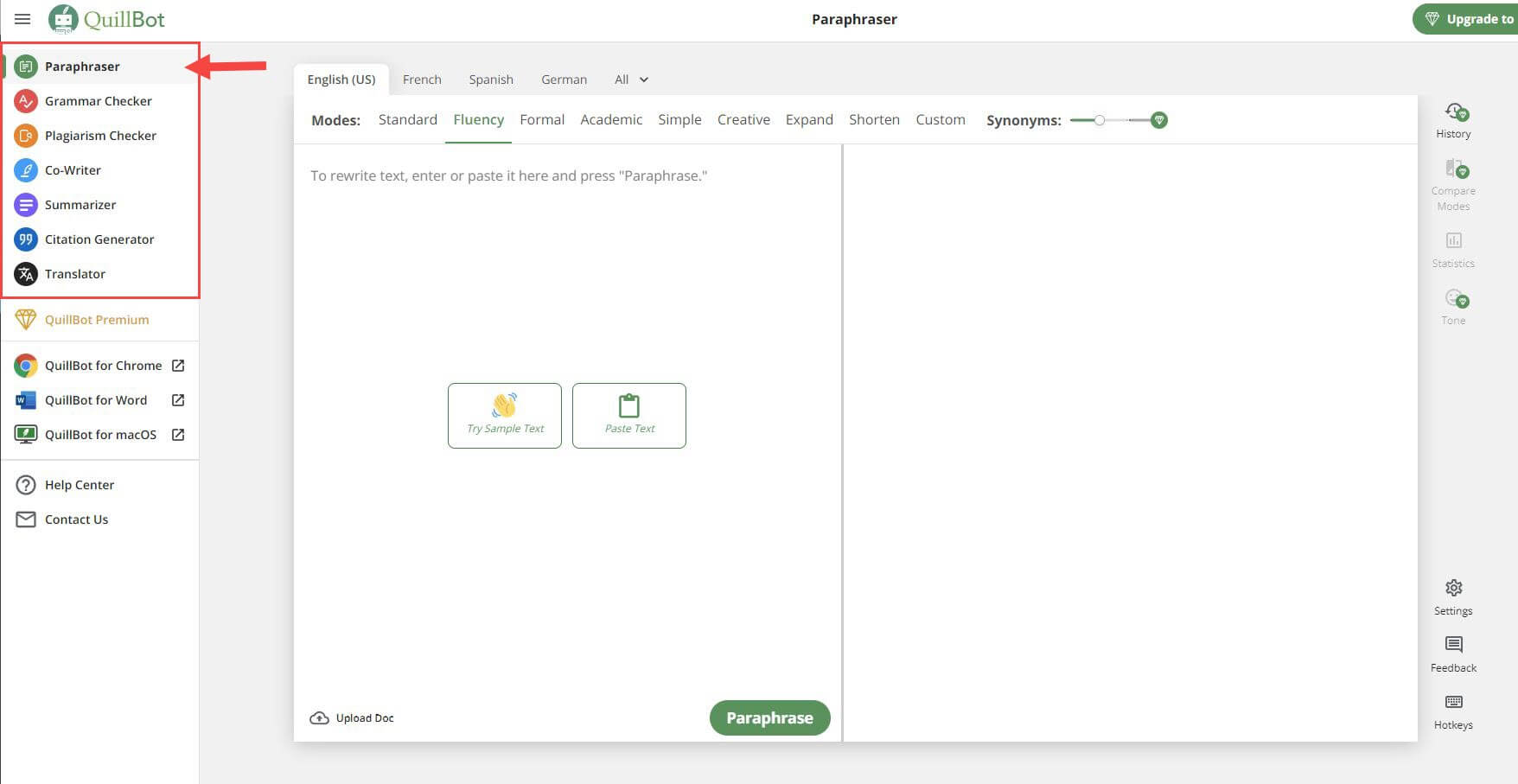
Each tool will have a consistent layout with different features that you can use to start refining your content. For example, when using the Grammar Checker, you can copy and paste your content into the user interface. QuillBot will readily analyze your text, pinpointing broken sentences and grammatical errors you can fix with a single click.
And the other other tools share the same easy-to-use interface and functionality. For instance, the Summarizer makes condensing long-form content or essays easy. Paste your text to generate a summary of key points. Additionally, it features a plagiarism checker, which helps identify and fix plagiarized content to ensure the originality of your content.
QuillBot’s AI functions by learning from datasets. Comprehending grammar, spelling, punctuation, tone, sentence structure, and readability, these datasets serve as knowledge accumulations. So, when users regularly disregard a specific suggestion, the AI adjusts to present more contextually relevant alternatives.
Breaking Down QuillBot AI Features
QuillBot AI offers several features for easy and effective content organization. We’ll delve into these features now.
1. The Paraphraser
QuillBot AI includes a paraphrasing tool. It empowers writers to rephrase text while preserving its central message. It’s an ideal tool for students and aspiring authors, requiring no account signup. Options for ‘Fewer Changes’ or ‘More Changes’ are available, with premium users getting maximum adjustments.
Paraphrase Modes
QuillBot AI assists users in paraphrasing and refining text. It employs seven unique modes, each tailored to specific objectives, to enhance the quality and readability of written content. Whether striving for clarity, professionalism, creativity, or conciseness, QuillBot AI offers a mode to suit your needs.
Here is an example sentence I added to the paraphraser text input area:
“It was a tough match. After three hours of immense struggle, I was able to get the job done.”
1. Standard Mode
Standard Mode serves as the default setting. It balances modifying the text for clarity and fluency while preserving the original meaning. The result is a refined text that maintains its natural flow and readability.
After clicking the Rephrase button, QuillBot swiftly provided a paraphrased output in Standard Mode. It merits noting that the level of paraphrasing hinges on the level of synonyms you set in the Synonyms bar at the right of the Modes bar above the content. The higher the level, the more liberty you give QuillBot to change the words of the original content.
The ensuing result was generated with a low Synonyms bar:
“It was a challenging game. I had to struggle for three hours before I was able to finish the task.”
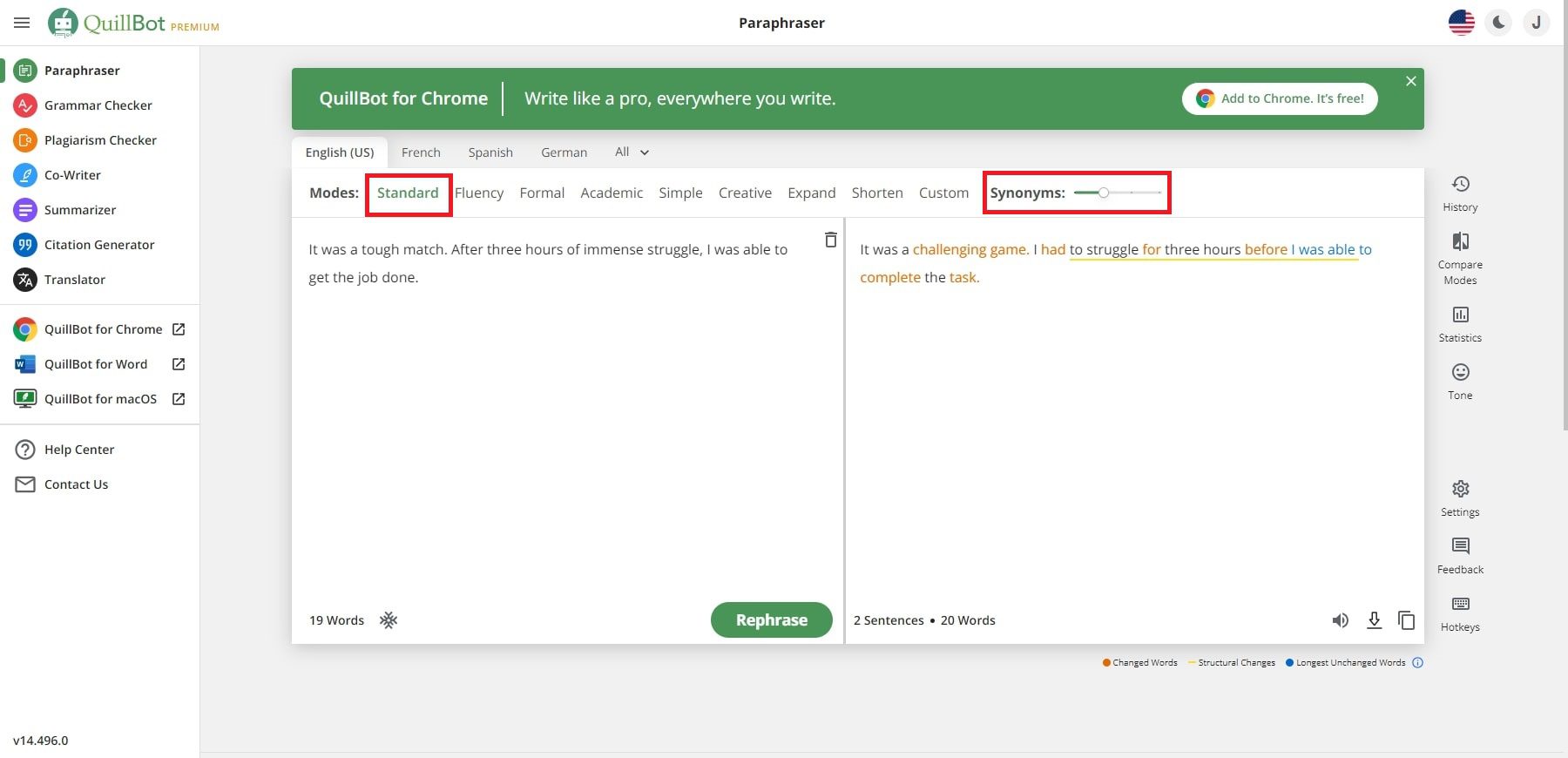
The following result was generated with a maximum level of Synonyms:
“It was a challenging game. I had to battle for three hours before I was able to finish the task.”
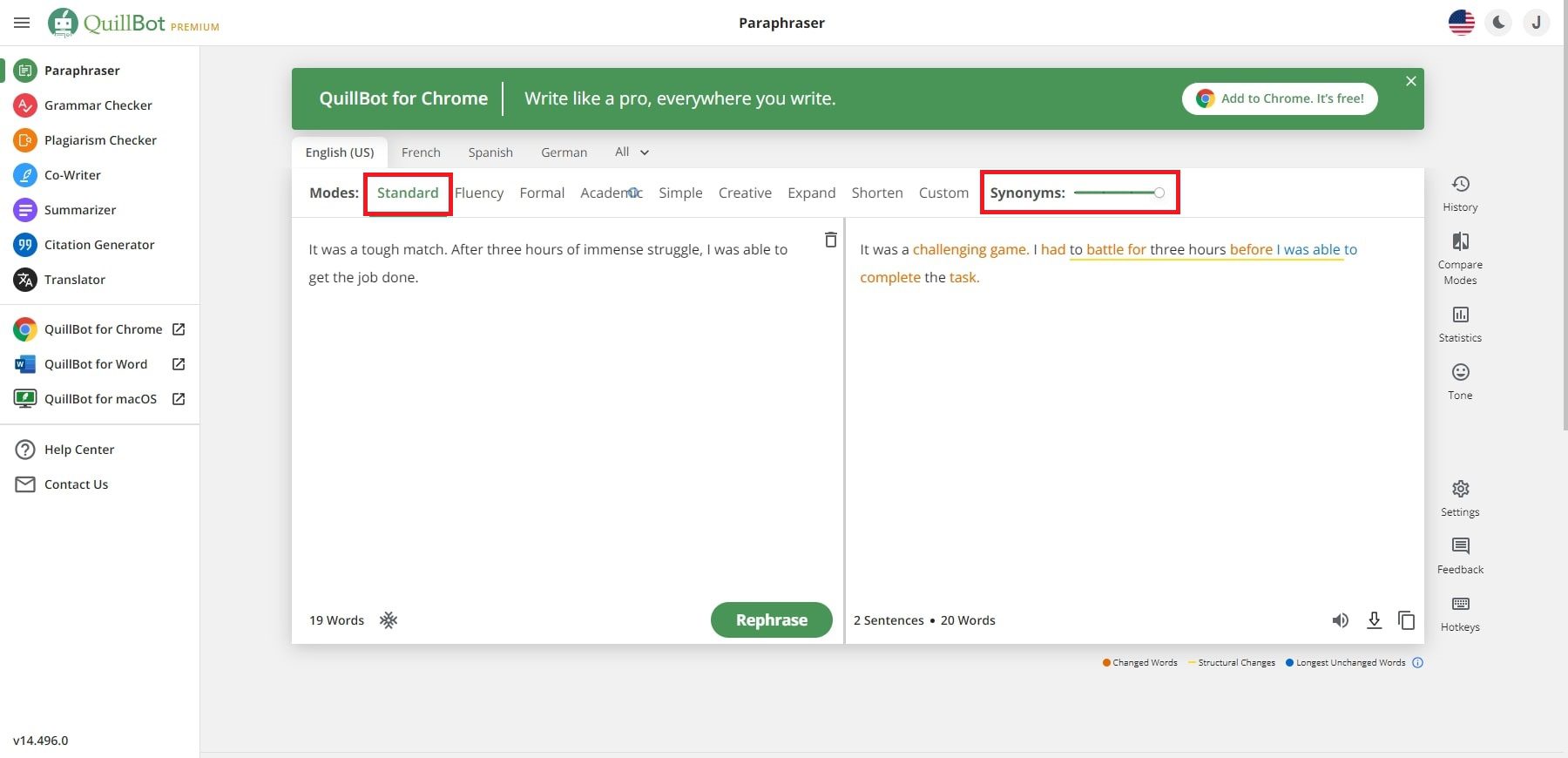
With just one sentence, you can see that only one word changed, but with larger blocks of content, you will see that QuillBot will make more word changes with a higher level of synonyms.
2. Fluency Mode
In Fluency Mode, QuillBot AI ensures that the text is grammatically sound and genuinely readable. It makes minimal changes, primarily correcting grammar and providing the text sounds natural. Synonym substitutions are kept to a minimum, preserving the original meaning.
We paraphrased the same content in Fluency mode . It generated the following output:
“It was a difficult match. I completed the task after three hours of intense effort.”
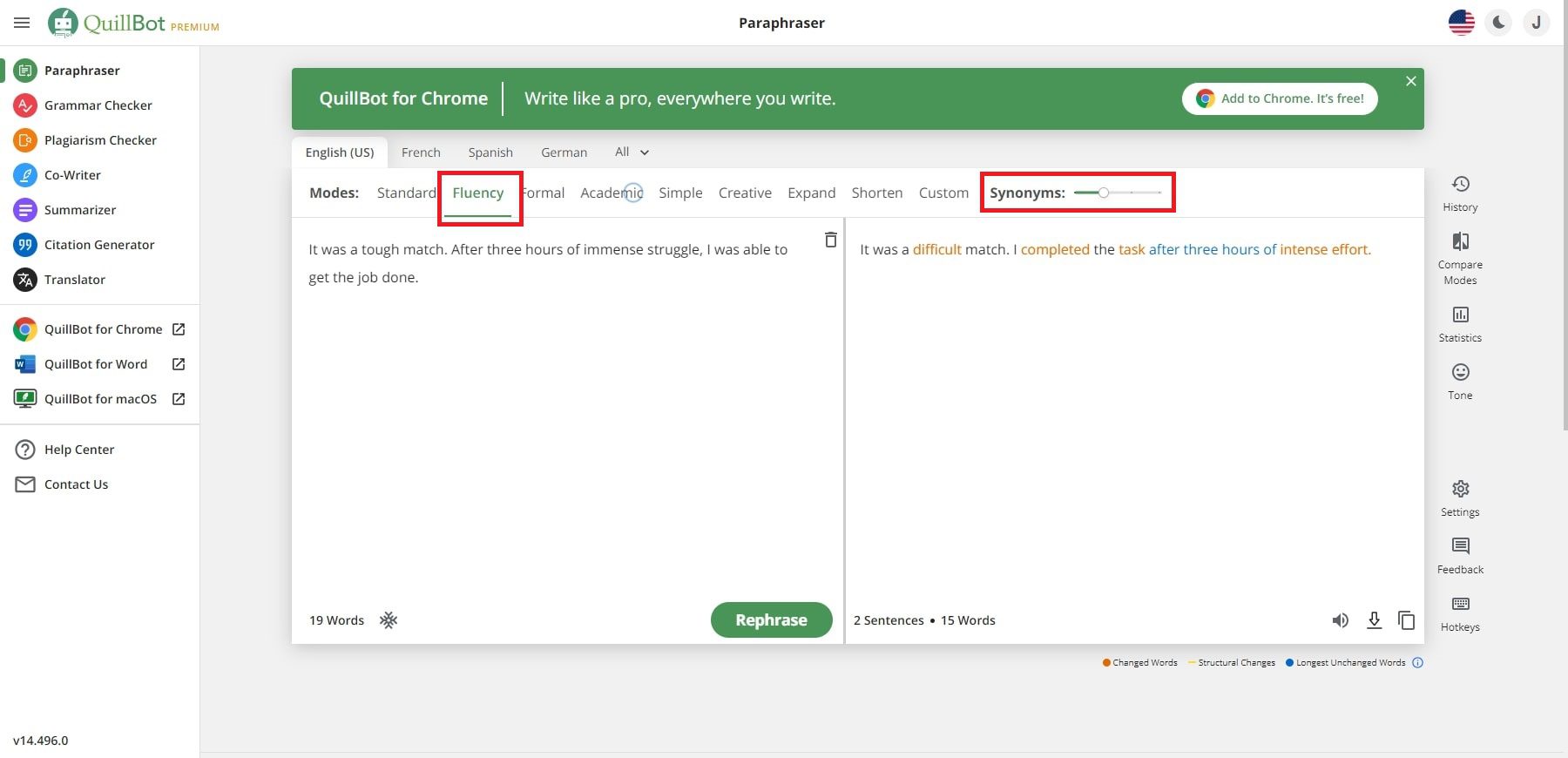
3. Formal Mode
Formal Mode is the ideal choice for those working in academic or professional contexts. It transforms the text to sound more polished and professional, making it suitable for business reports, academic papers, and formal documents.
We paraphrased the same content in Formal Mode . It generated the following output:
“ It was a difficult match. After three hours of arduous effort, I was able to complete the task. ”
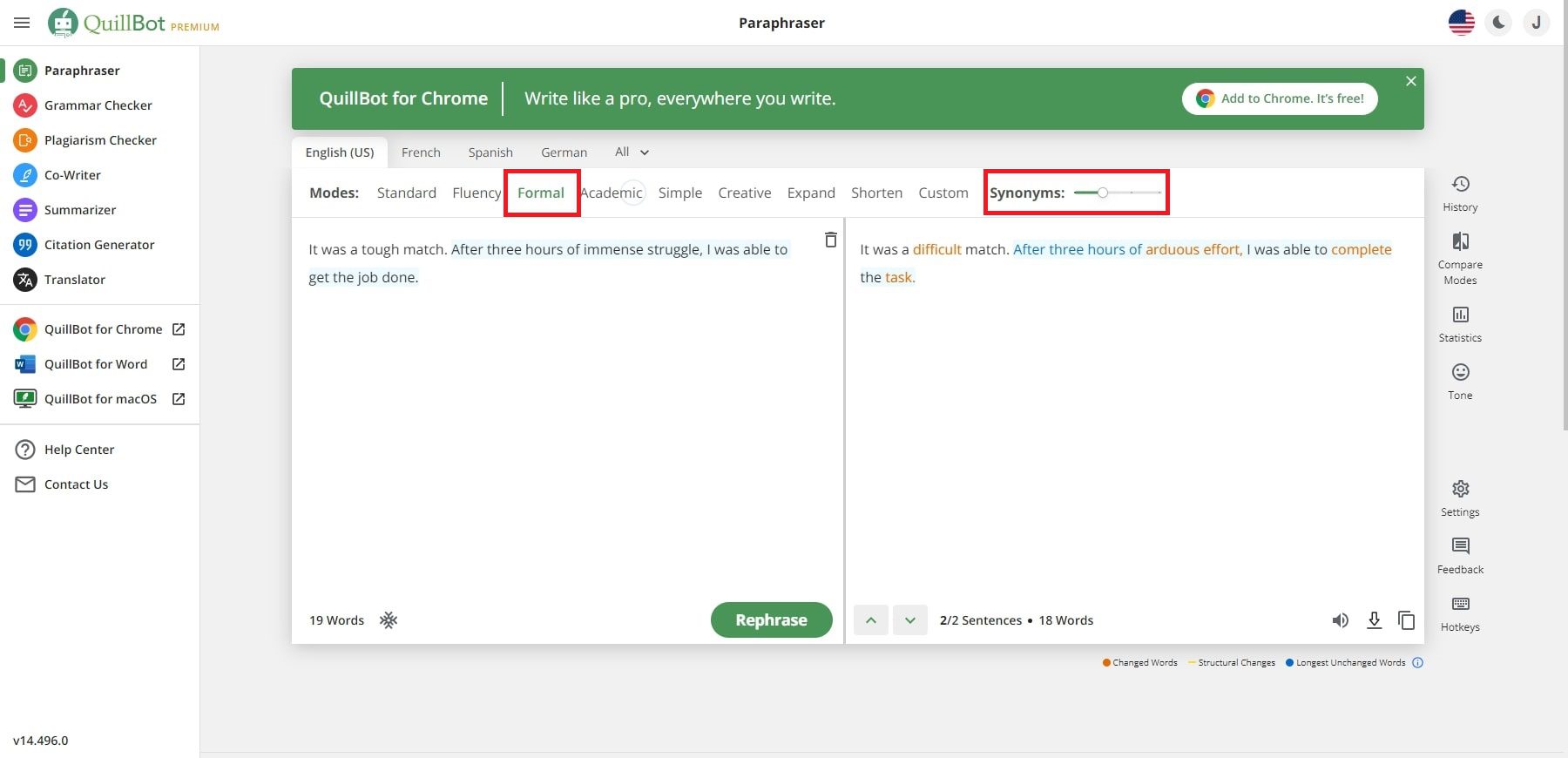
4. Academic Mode
Then, we paraphrased the same content in Academic Mode . Unlike the other modes, it doesn’t have any Synonyms bar. Instead, it seemed to give the content more details and wording suitable for academia. It generated the following output:
“ The contest was challenging. Following a prolonged period of three hours, characterized by significant exertion and effort, I successfully completed the task at hand. ”
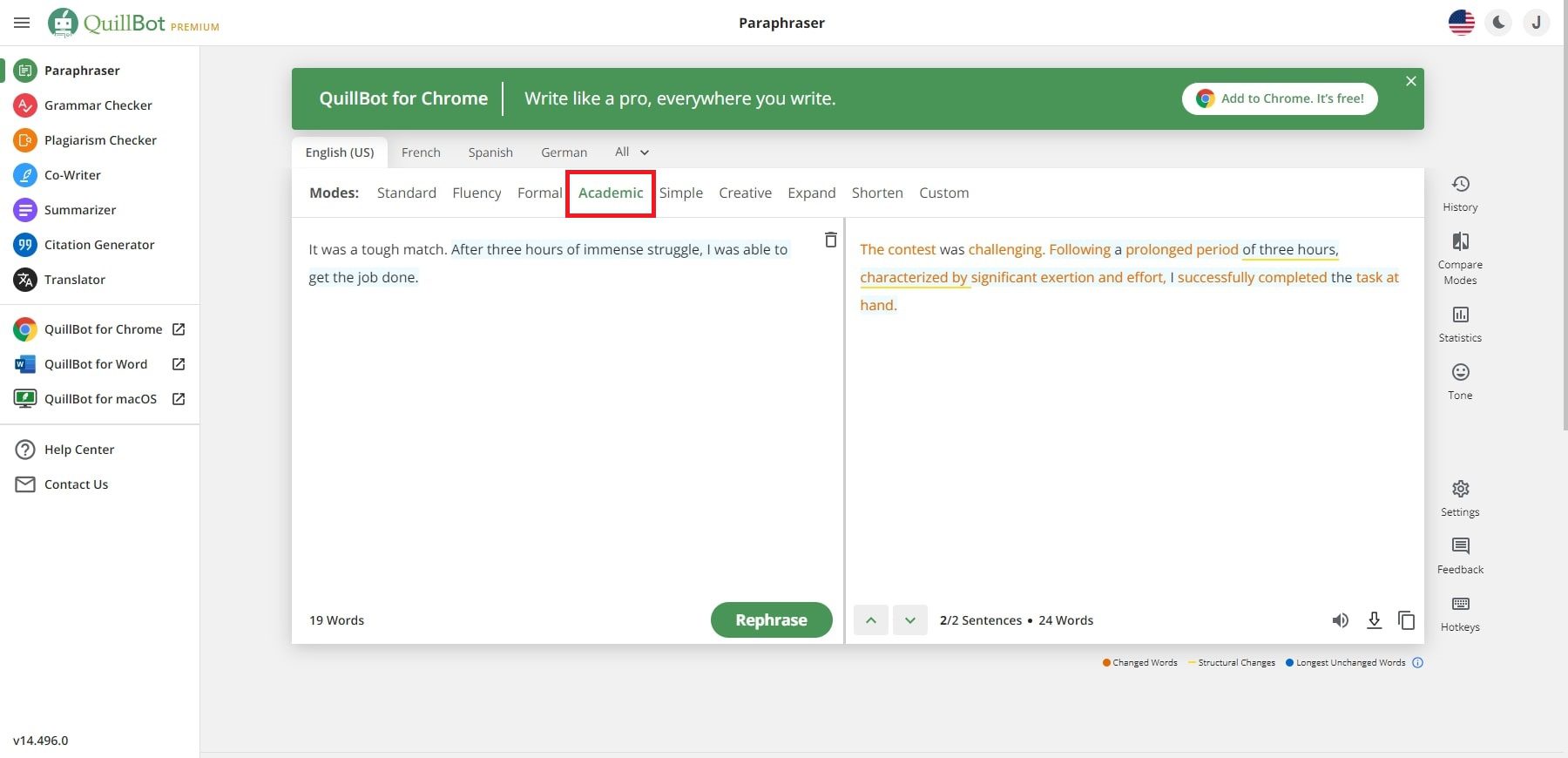
5. Simple Mode
Simple Mode simplifies the text, making it easier to understand and more accessible to a broader audience. It is an excellent choice when clarity and straightforward communication are essential.
We paraphrased the same content in Simple Mode . It generated the following output:
“ It was a hard game. I was able to finish the job after three hours of hard work. ”
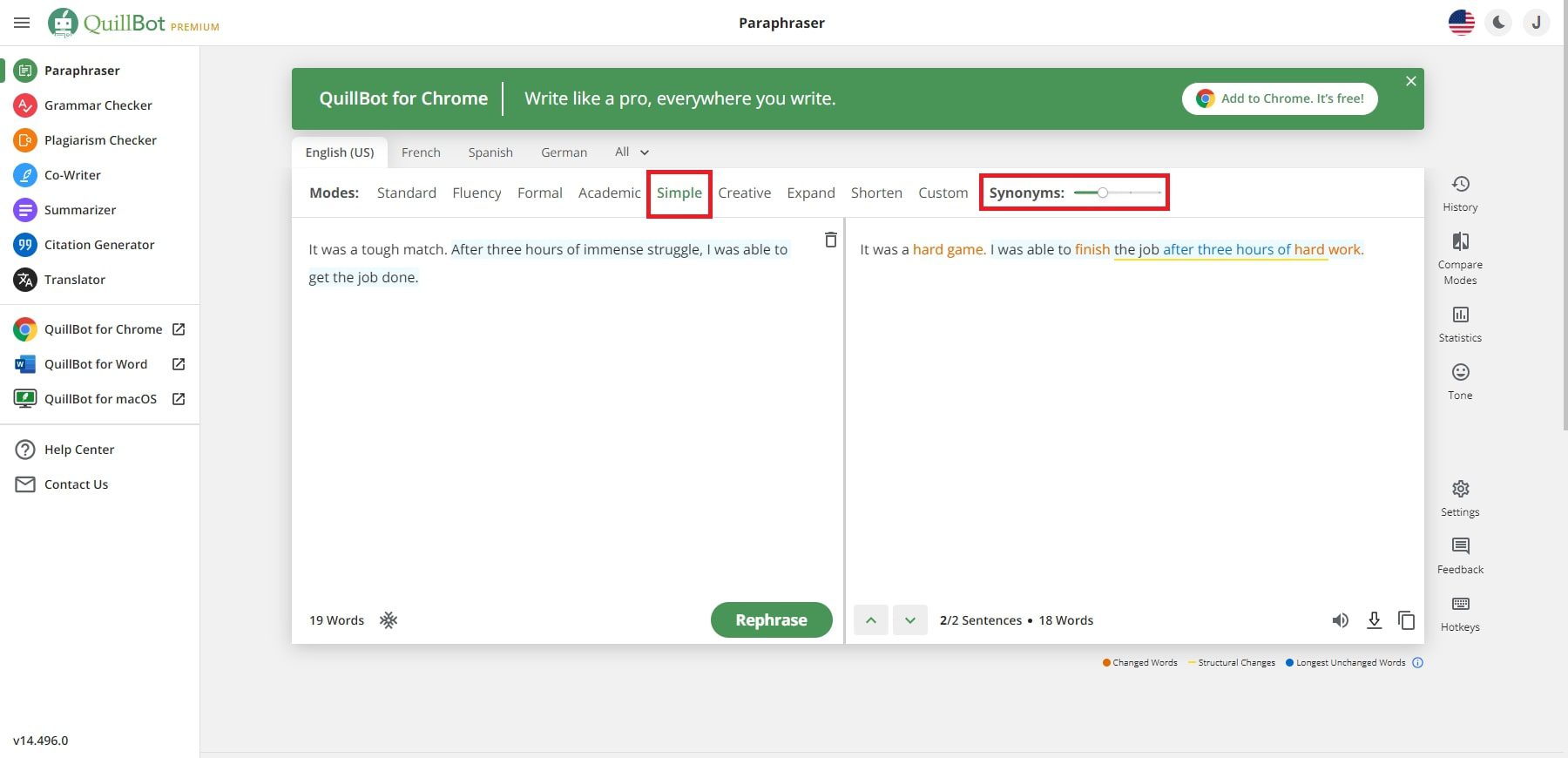
6. Creative Mode
Creative Mode is the way to go if you’re looking to unleash your creativity and generate entirely unique content. This Mode substantially changes the text, potentially altering the original meaning. It’s a valuable tool for content creators seeking a fresh spin on their writing.
We paraphrased the same content in Creative Mode . It generated the following output:
“ That was one intense contest. It took me three hours of relentless effort, but I finally completed the task at hand. ”
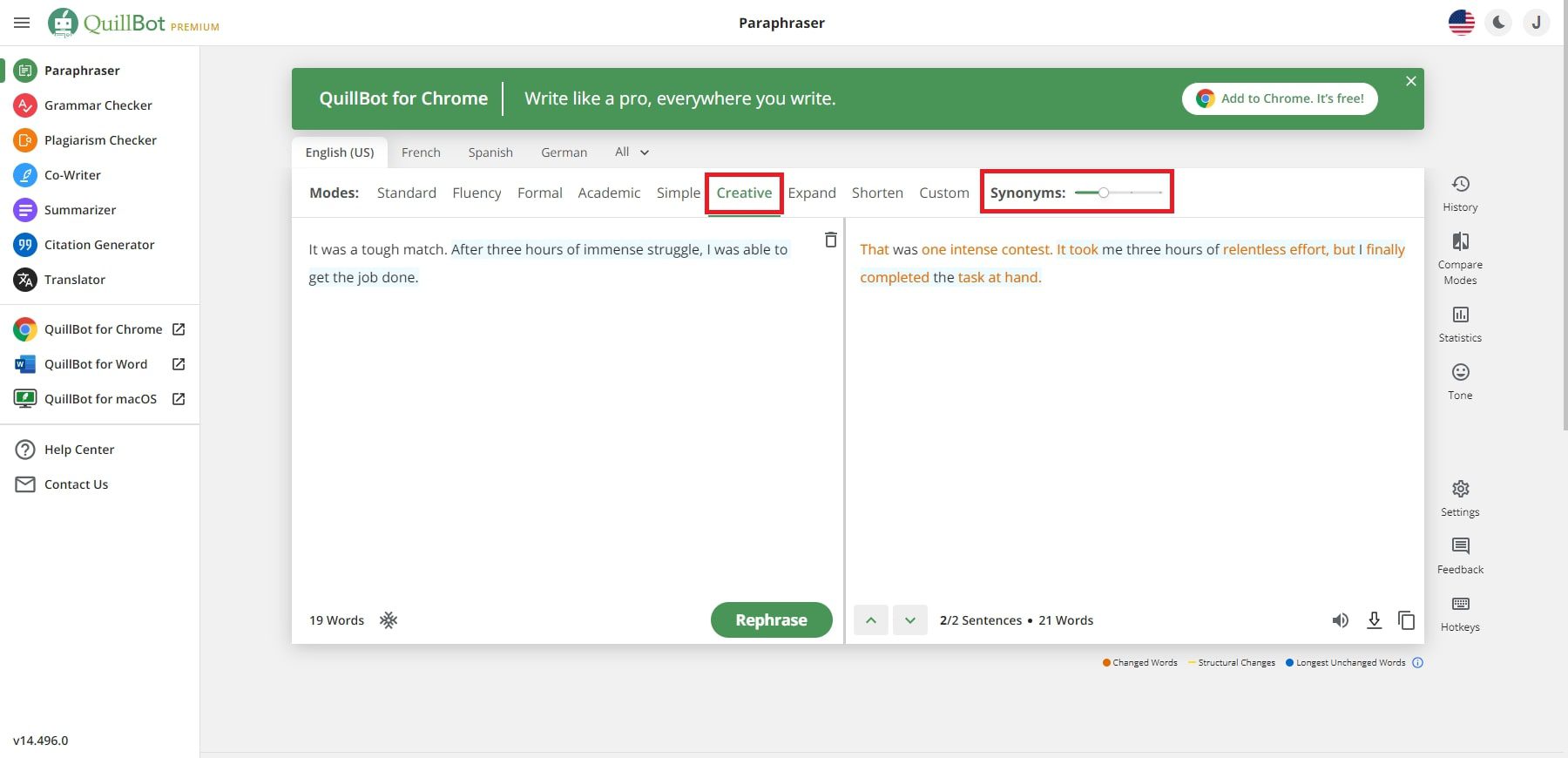
7. Expand Mode
Expand Mode is perfect for those aiming to increase the length of their text. It adds words and details while retaining the original meaning, making it valuable for projects requiring a higher word count.
We paraphrased the same content in Expand Mode . It generated the following output:
“ It was a difficult match to watch. I had to put in a lot of effort for three hours before I was finally successful in completing the task. ”
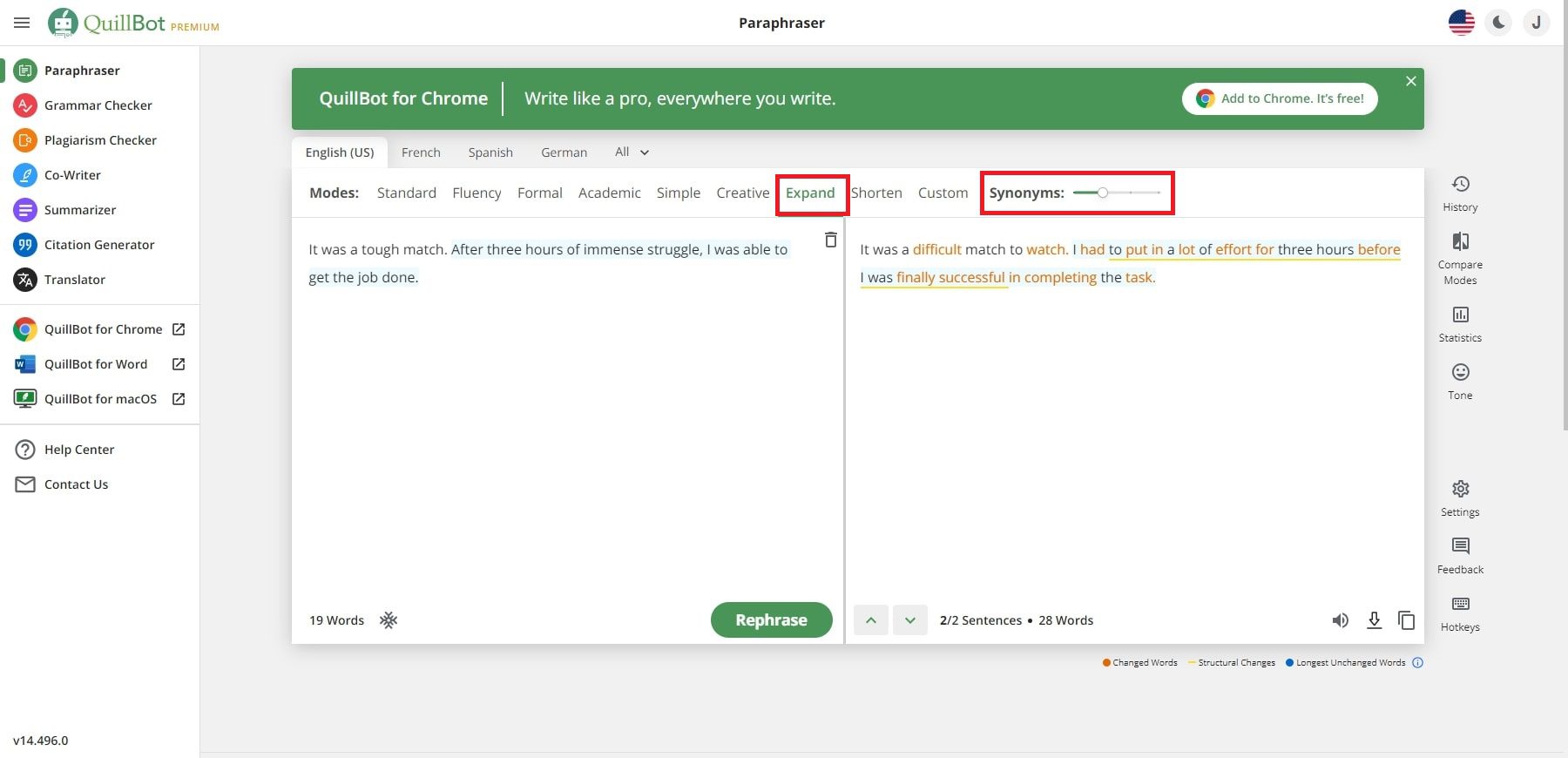
Then, we produced an output with a high level of Synonyms as follows:
“The contest was a challenging one. I was able to finish the work, despite the fact that it took me three hours of intense effort.”
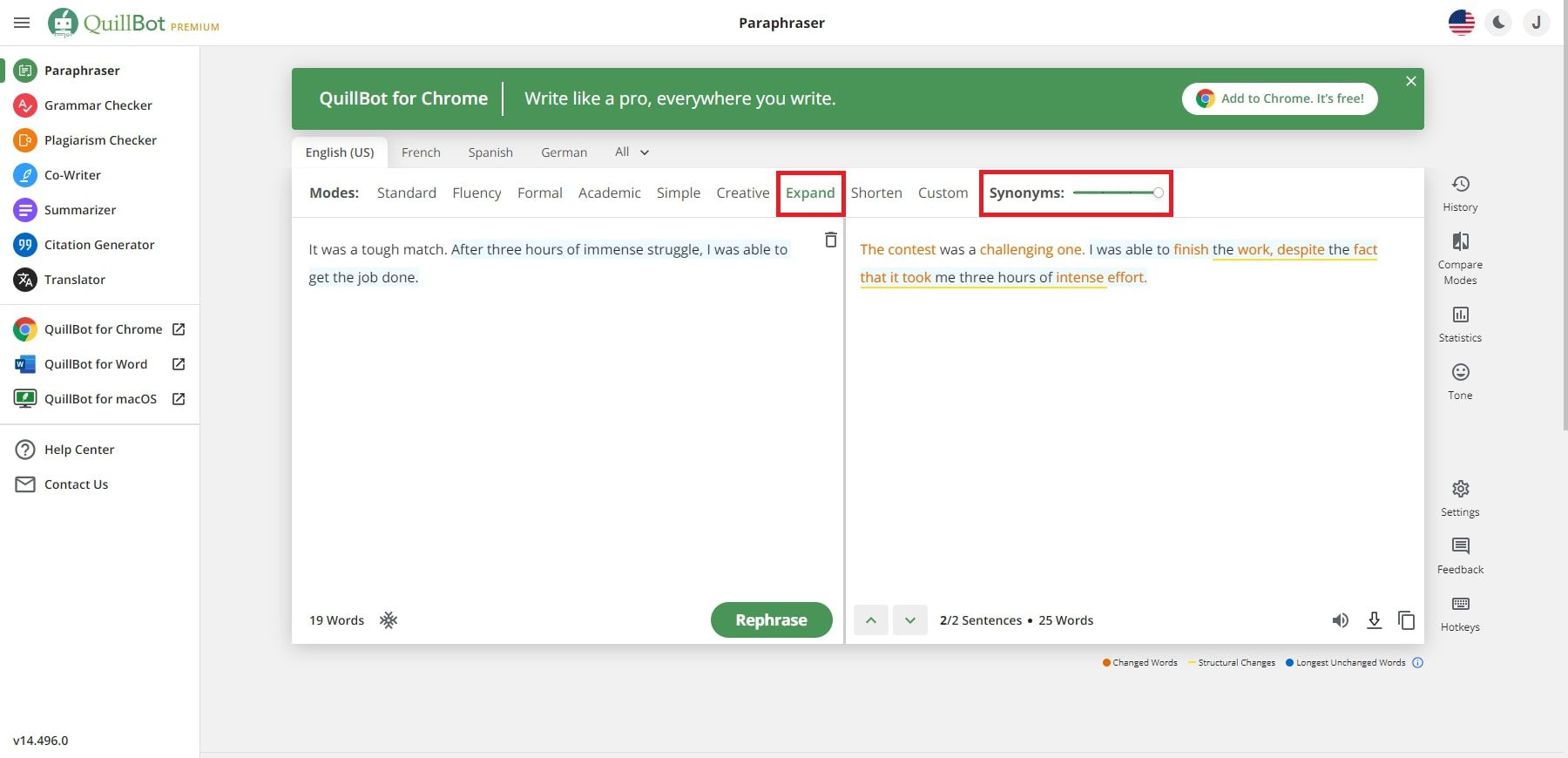
8. Shorten Mode
Shorten Mode comes to the rescue when you need to reduce the overall word count while maintaining the essence of your text. It trims unnecessary words and phrases, delivering a concise version of your content.
Lastly, we paraphrased the same content in Shorten Mode. It generated the following output:
“ The match was hard. I finished after three hours of intense struggle. ”
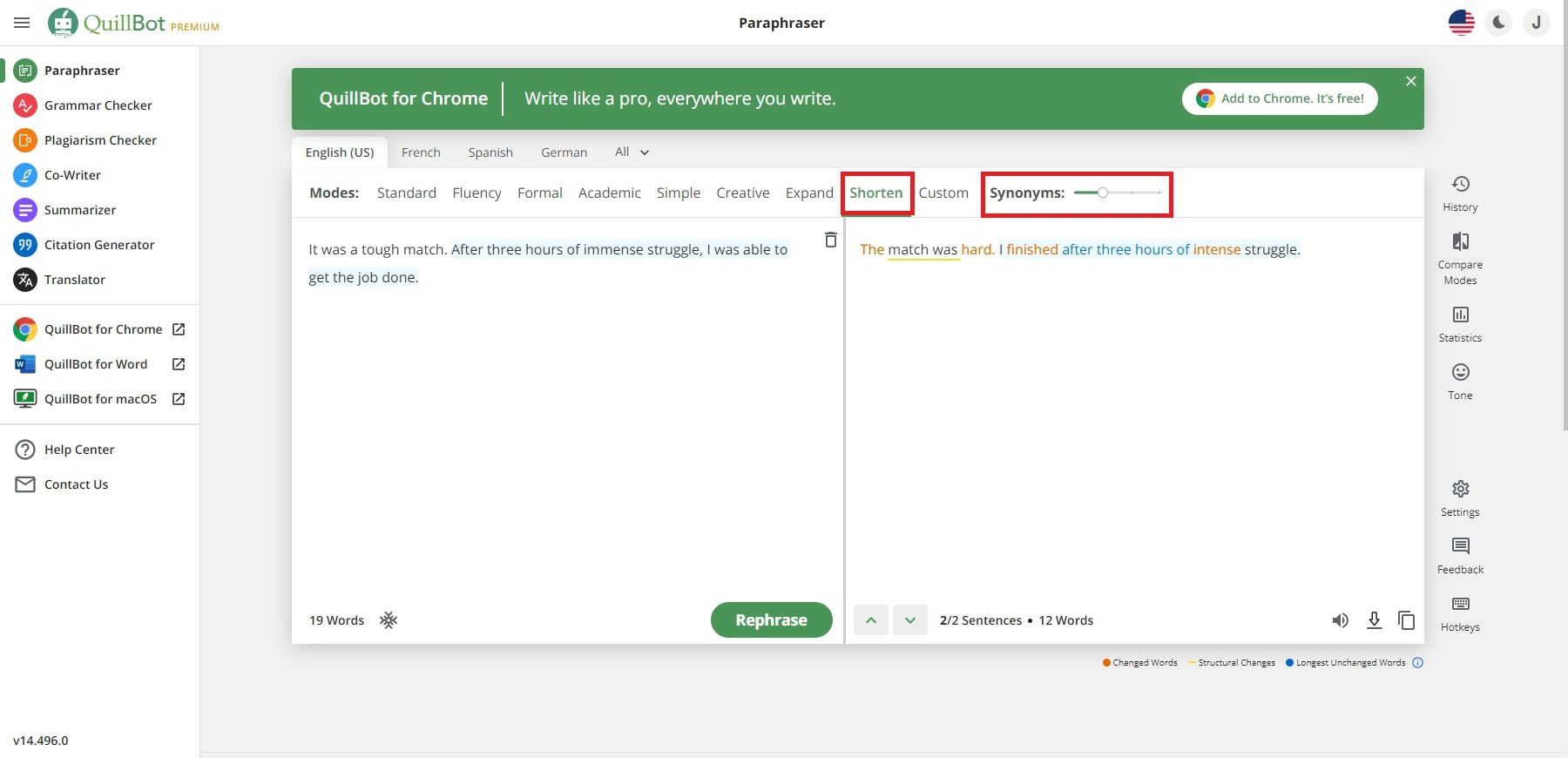
Paraphraser Statistics
The ‘Statistics’ feature offers insights into text complexity and readability. It aids writers in adjusting their style to the desired tone and audience. Premium subscribers unlock tonality analysis, which assesses reader perceptions to enhance persuasive writing.
I have used the same content as the previous one in the “Fluency” mode. It has generated the following statistics.
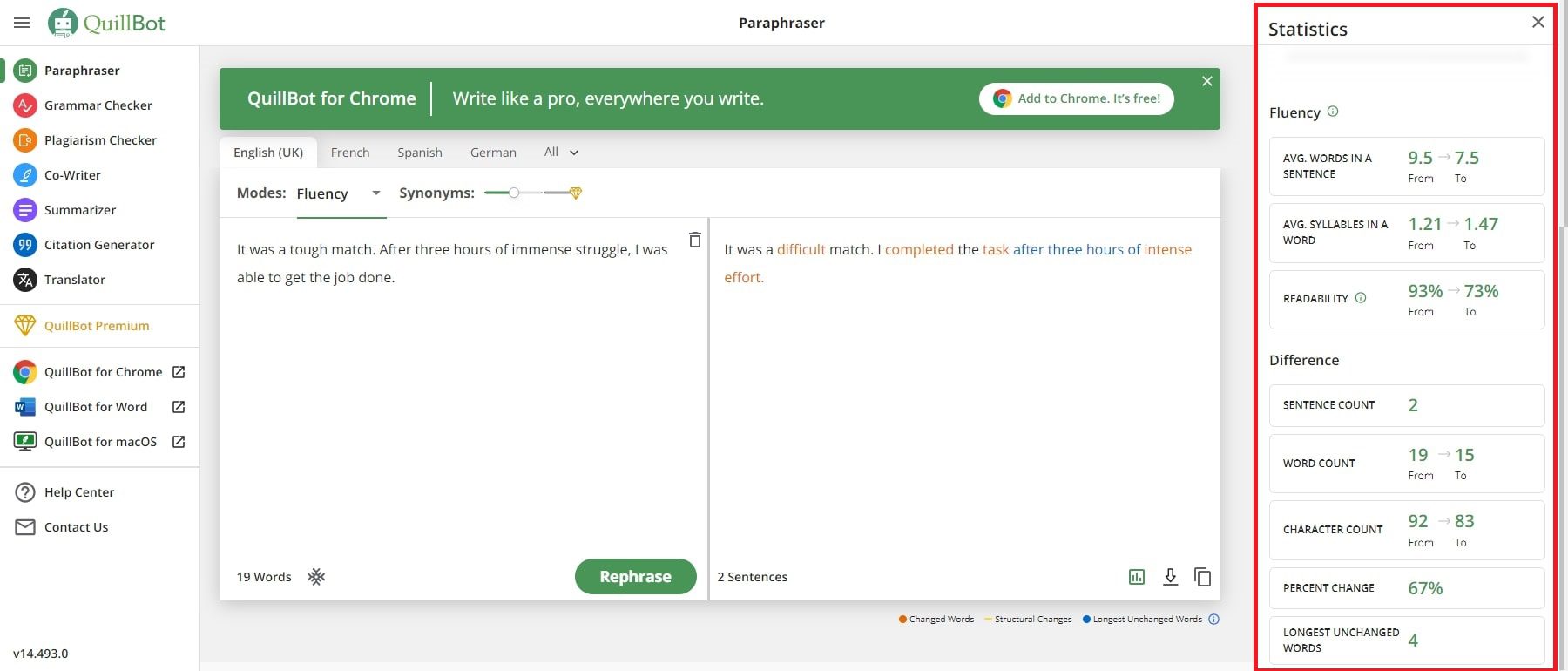
The Statistics of the generated content are based on the following aspects:
- Average words in a sentence
- Average Syllables in a word
- Readability
- Sentence Count
- Character Count
- Percent Change
- Longest Unchanged Words
Paraphraser Settings
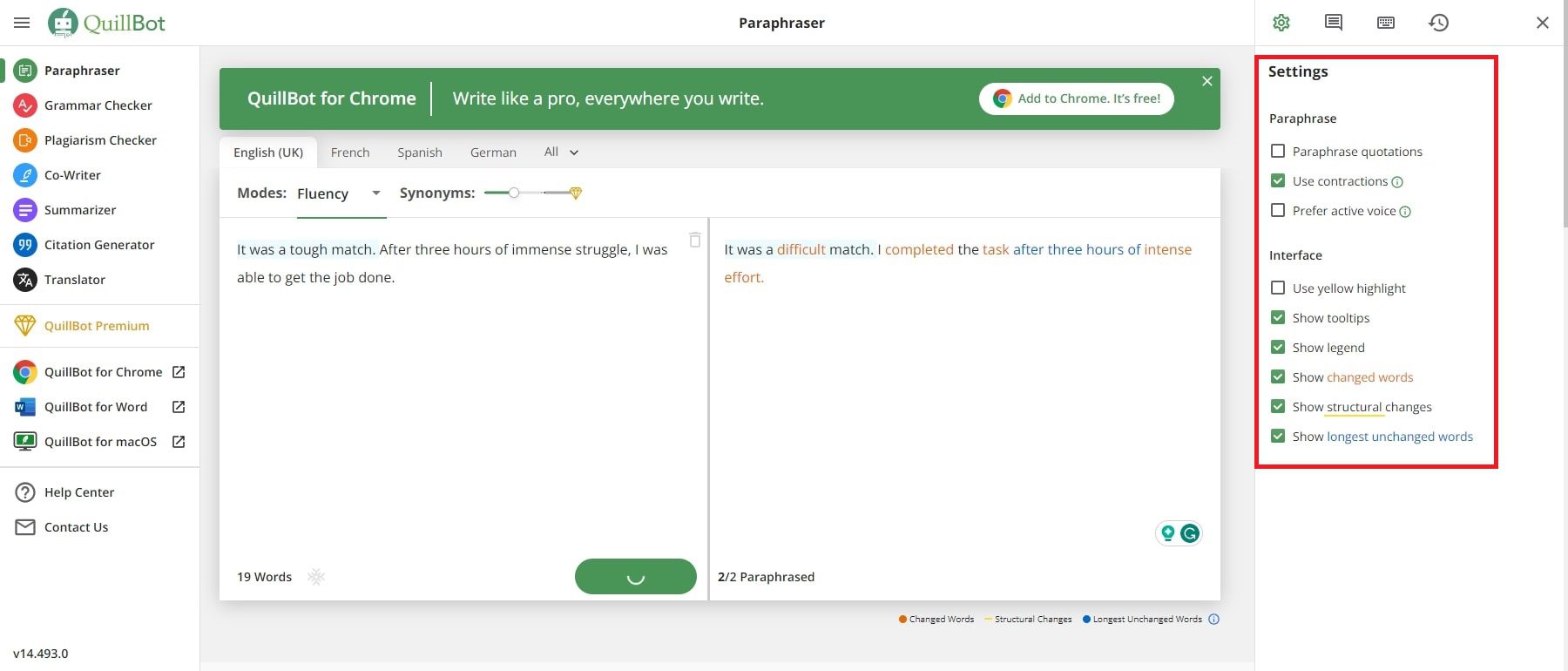
The “Settings” feature in the Paraphraser tool provides options to control how you want your content to be paraphrased and how you want the results to be displayed on the interface. In terms of paraphrasing the content, you choose the following:
- Paraphrase quotations
- Use contractions
- Prefer active voice
Under the Interface options, you can select the following:
- Use yellow highlight
- Show tooltips
- Show legend
- Show changed words
- Show structural changes
- Show the longest unchanged words
Overall, these settings do seem to give users more control and help them identify changes to their content much easier.
Paraphraser Compare Modes
Compare Modes is a valuable feature exclusively available to premium users, offering a comprehensive view of how a sentence is transformed across different modes within the platform. This feature enables users to evaluate and choose the most suitable rendition for their content by comparing various paraphrased versions. To access Compare Modes, locate and click on the dedicated icon in the settings bar on the right side of the page.
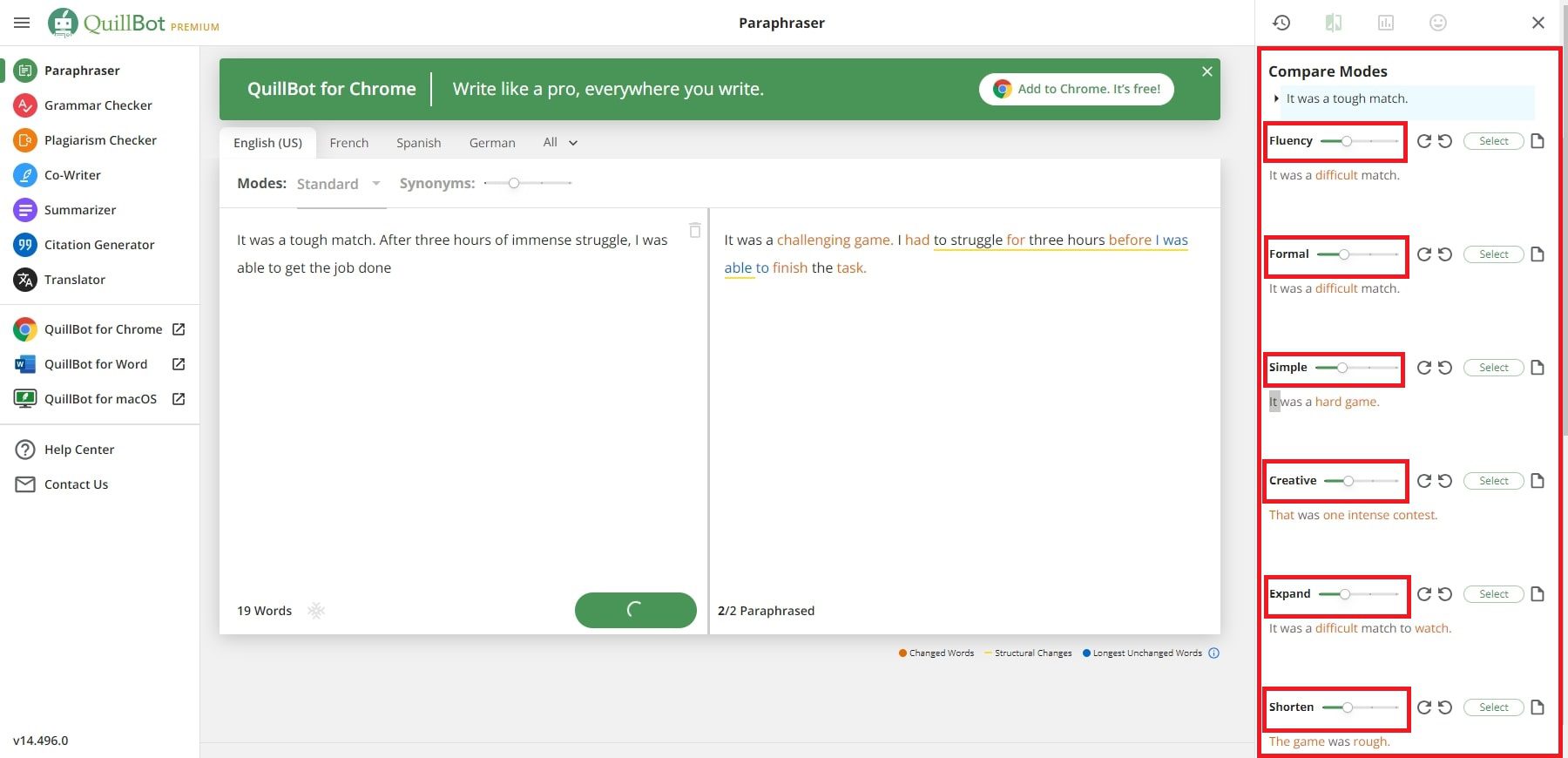
Once activated, Compare Modes opens a sidebar on the right-hand side of the screen, displaying the original sentence before paraphrasing and the results generated by all available modes simultaneously. The system defaults to the effect produced by the Mode in which the sentence was paraphrased. You can easily click the “Select” button next to the desired text to select your preferred sentence, seamlessly replacing the paraphrased sentence in your results. Additionally, you can further modify individual sentence results by clicking on circular arrow icons or making copies of them with a simple click on the copy icon. This powerful feature empowers users to fine-tune their content according to their specific needs and preferences, streamlining the content creation process.
Paraphraser History
By accessing the history feature, you can go through all the previous content you have modified. In my case, I checked my history, and it showed the last text paraphrased. It also shares the date and time when the content was modified.
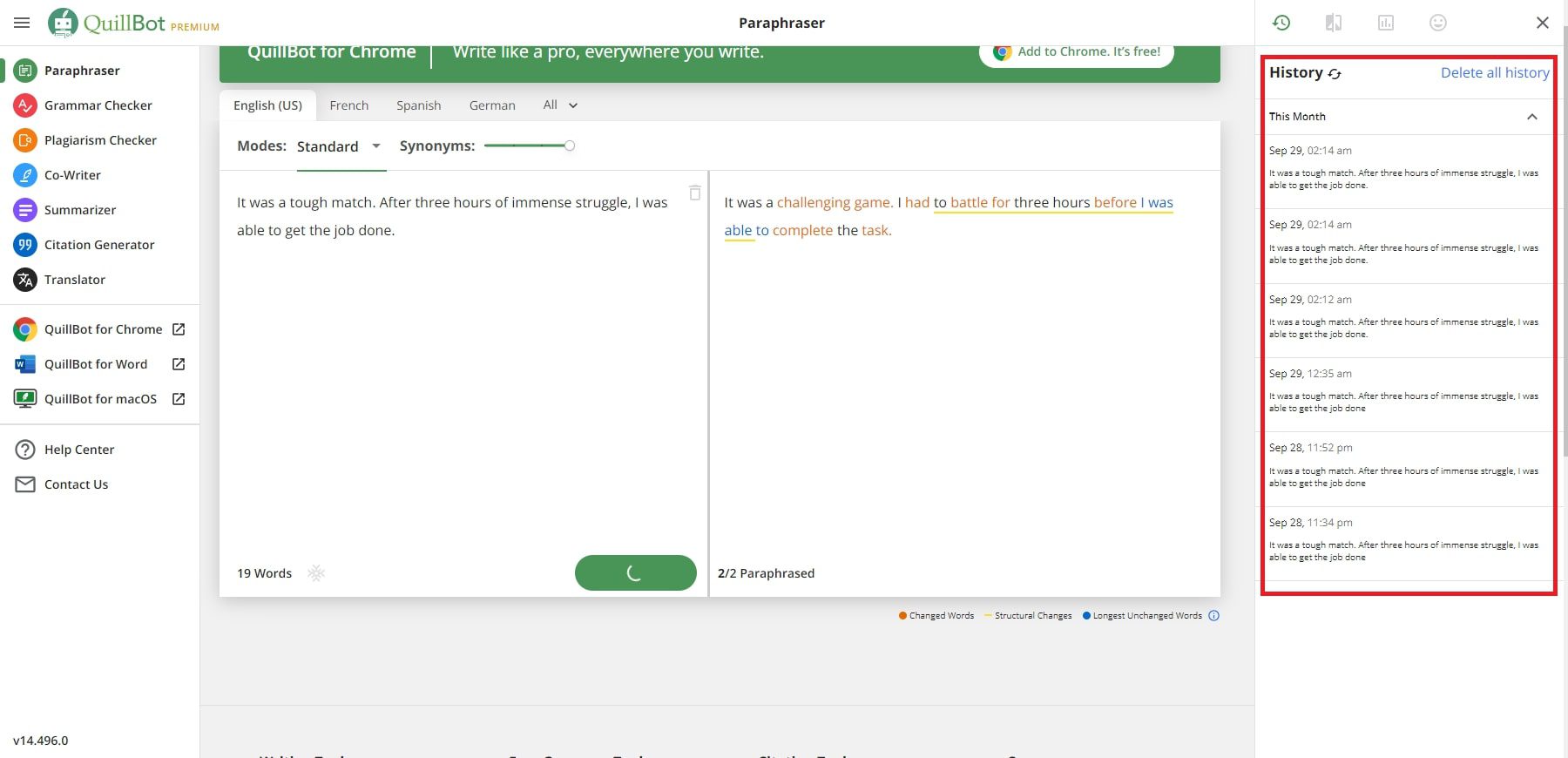
The “Tone” feature in QuillBot AI paraphraser allows users to control and tailor the emotional and stylistic tone of their paraphrased content. With this feature, users can choose from various preset tones, such as casual , unfriendly , wordy , complex , and unclear . It ensures that the paraphrased text aligns perfectly with the desired style and intent. Whether you need your content to sound professional and academic or friendly and conversational, the Tone feature empowers you to achieve the right mood for your writing.
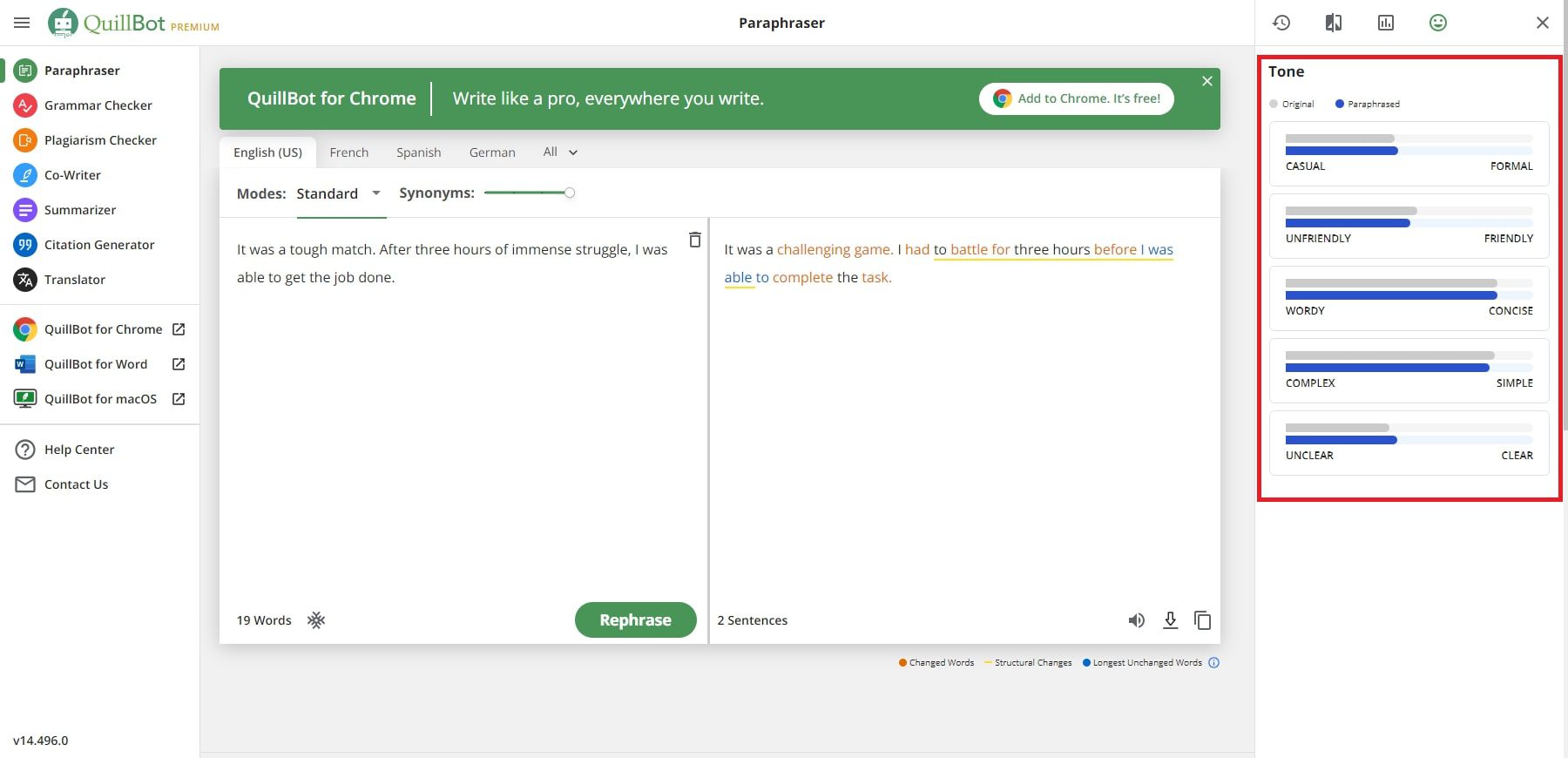
Paraphrasing for Different Languages
Quillbot AI supports 23 different languages for paraphrasing purposes. Not only does this make the tool more accessible, but it also comes in handy for making tweaks to the content generator by Quillbot’s translator tool.
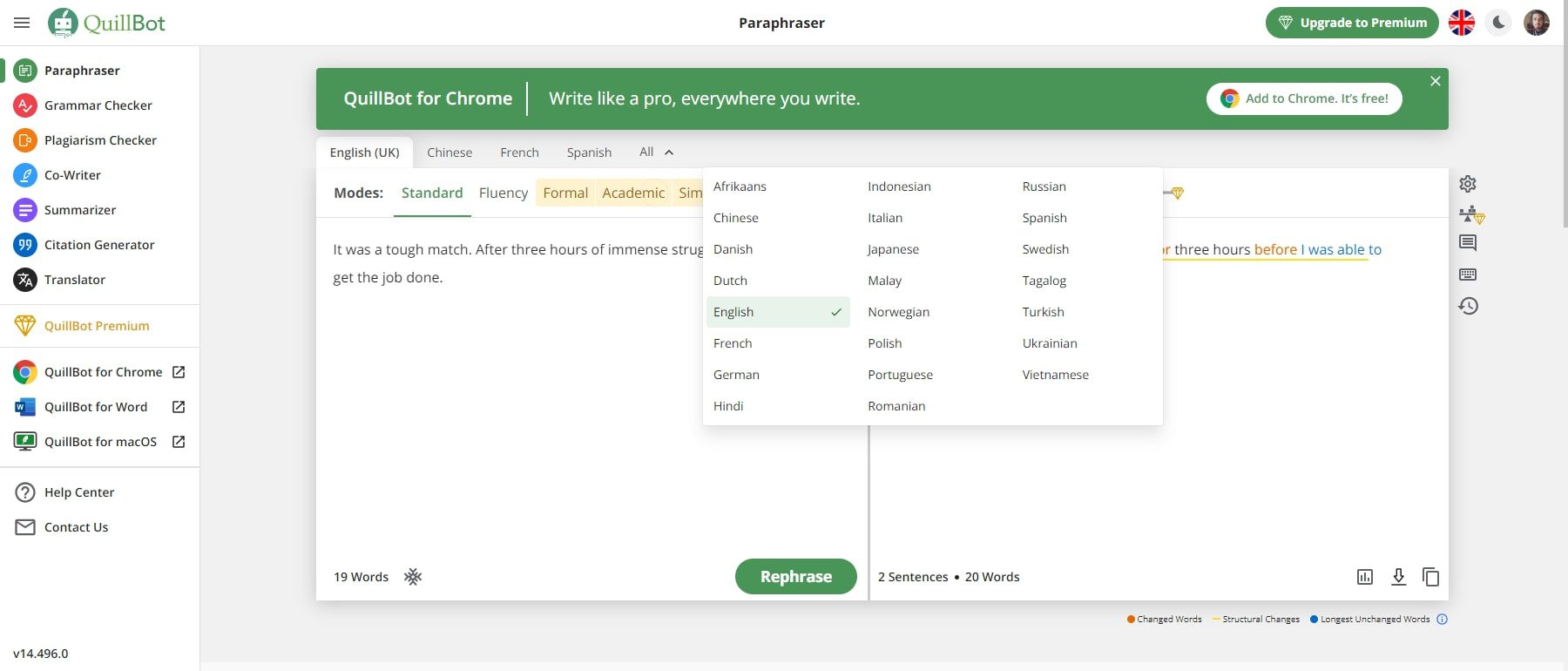
2. The Grammar Checker
Quillbot AI offers a user-friendly and free Grammar-checking feature that doesn’t require signing up. When you paste your text into Quillbot’s editor, it identifies and highlights grammatical errors, including punctuation and spelling. With a convenient Fix All Errors option, you can swiftly correct multiple issues simultaneously. This Grammar Checker enhances writing precision and consistency. It quickly pinpoints potential errors in red, simplifying the editing process. This real-time underlining and instant correction feature saves writers time and improves productivity.
For instance, here is an example sentence I added to the grammar checker text input area:
“ Manchester United signed Sofyan Amrabat on a season-long loan move from Fiorentina. The Morocco midfielder has been desperate to join Erik ten Hag’s team since getting linked to the Red Devils in June. However, Manchester United’s plans differed on Deadline Day as they wanted to sign Fulham’s Joao Palhinha instead. ”
After copy-pasting the text into the Grammar Check, it will detect all the potential errors within the content. By putting your cursor on the underlined words, it will show you the errors individually.
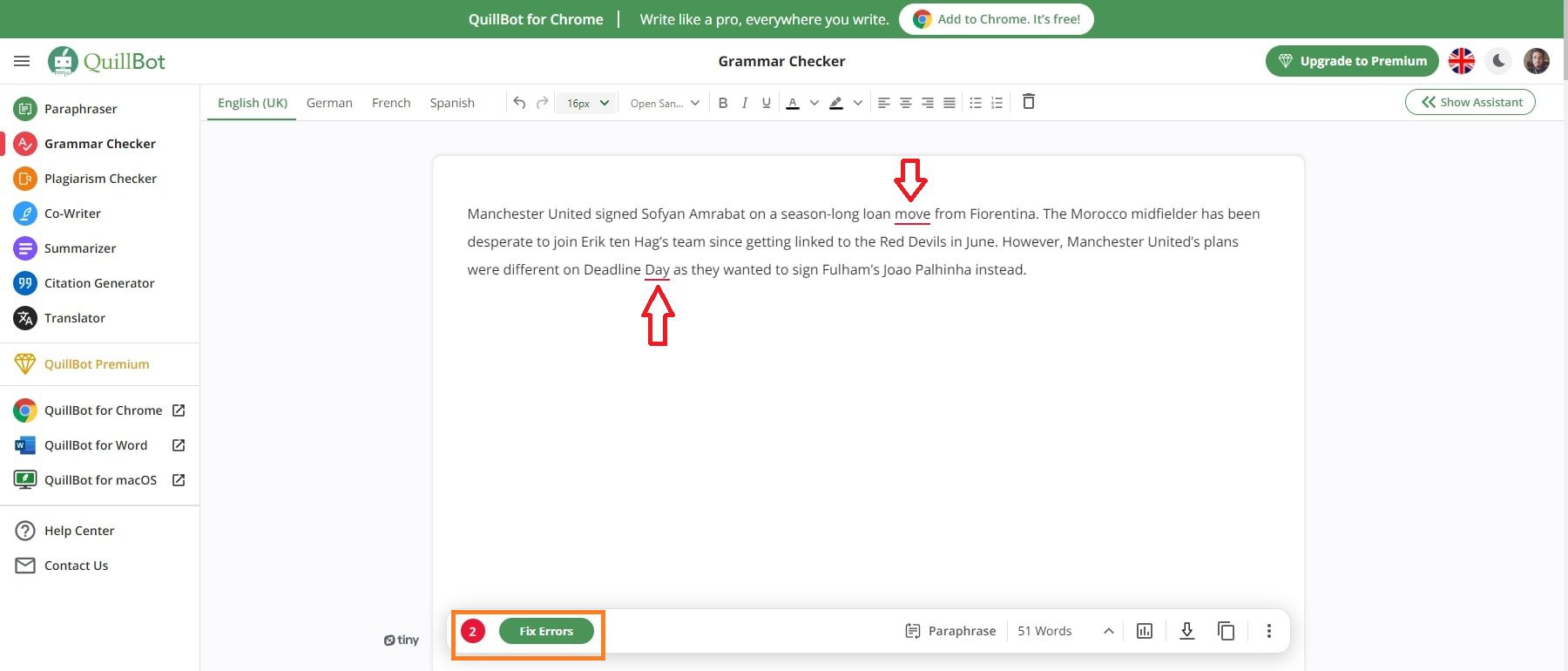
Once you remove all the errors, it will provide you with the correct grammatical content. It will generate the following content.
“ Manchester United signed Sofyan Amrabat on a season-long loan deal from Fiorentina. The Morocco midfielder has been desperate to join Erik ten Hag’s team since getting linked to the Red Devils in June. However, Manchester United’s plans were different on Deadline Day, as they wanted to sign Fulham’s Joao Palhinha instead. ”
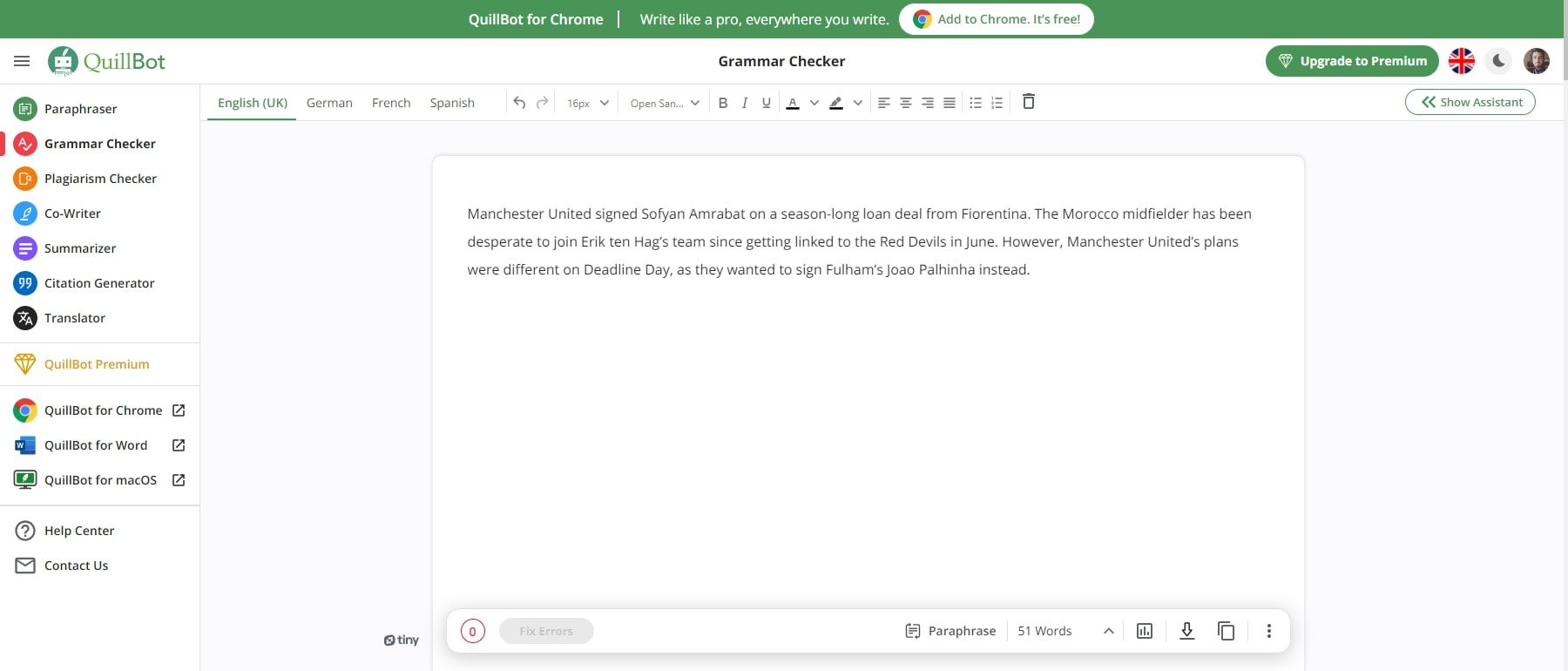
Furthermore, it seamlessly integrates with Quillbot’s Paraphrase tool, offering a comprehensive writing experience without needing an account. Its grammar-checking feature is valuable for writers seeking error-free, professional content.
3. Summarizer
Quillbot AI provides a Summarizer tool that condenses lengthy texts or articles into concise summaries, making it invaluable for students, researchers, and professionals.
Users can choose between Short and Long summarization options to control the level of detail. The Short summarization offers a brief overview, ideal for quickly grasping the central ideas or skimming through multiple articles. In contrast, the Long outline provides a more comprehensive summary, suitable for in-depth analysis or a deeper understanding of the text.
Quillbot AI’s Summarizer utilizes natural language processing to extract critical information while preserving the original context. It offers two summarization types: Key Sentences and Paragraph modes.
For instance, I added a block of content to the summarizer text input area. Using the Key Sentences feature, the tool has created five articulate points that summarize the content.
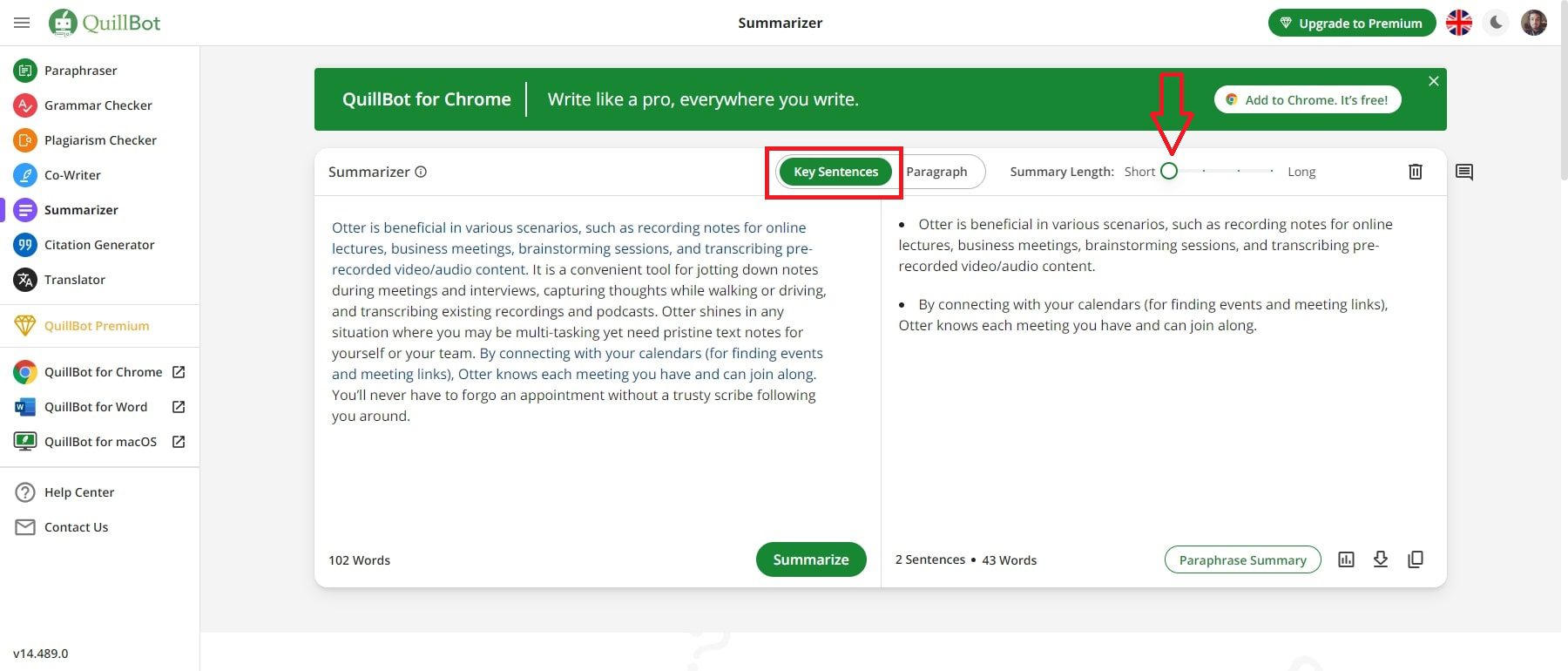
Changing the Summary Length can increase or decrease the depth of those points.
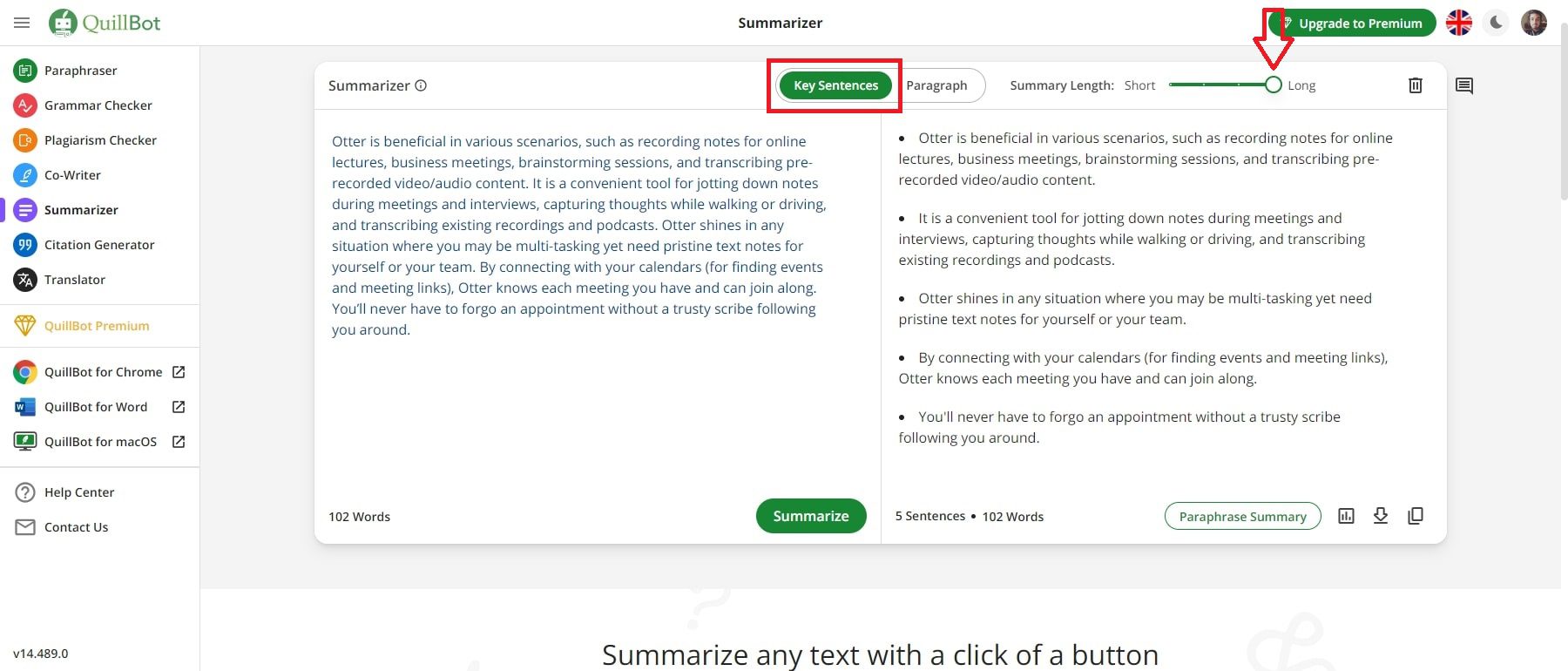
Selecting the Paragraph mode will provide a summary of the content in paragraph form.
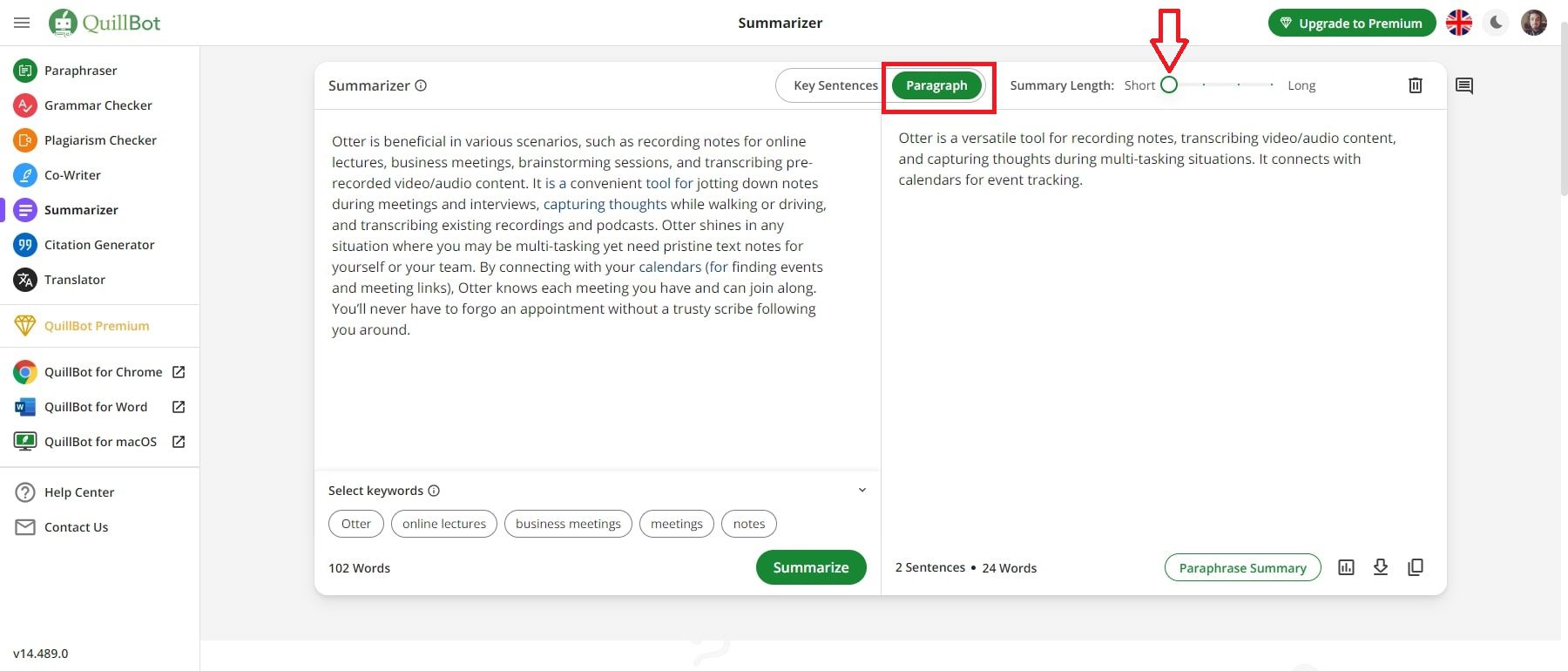
Like the Key Sentences mode, the length of the summary can be changed by adjusting the Summary Length .
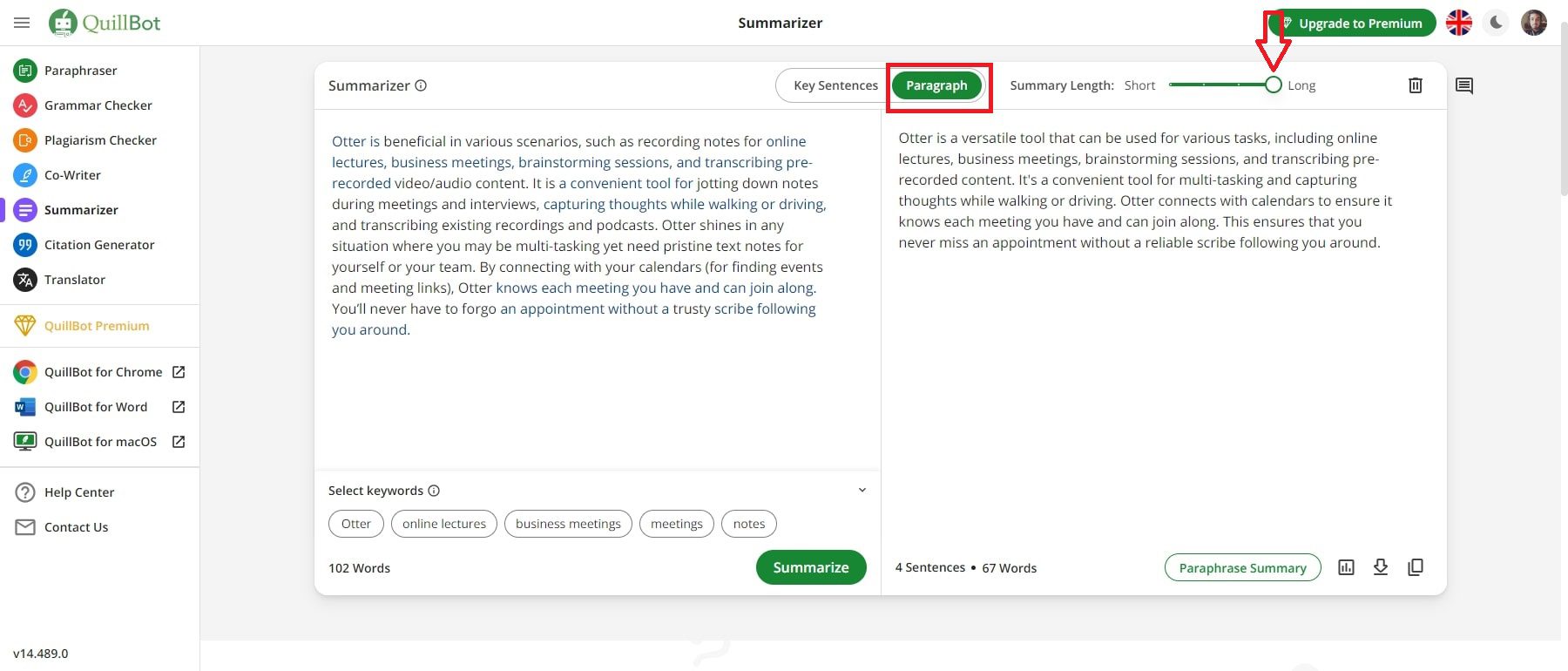
This feature streamlines research, study, and content review processes, enhancing productivity and comprehension for users across various fields.
4. Citation Generator

QuillBot’s Citation Generator is a valuable tool that simplifies the often complex process of citing sources in academic and professional writing. It allows users to choose from various citation styles and formats, ensuring compliance with specific guidelines and educational requirements. This feature dramatically reduces the potential headache associated with accurate source attribution.
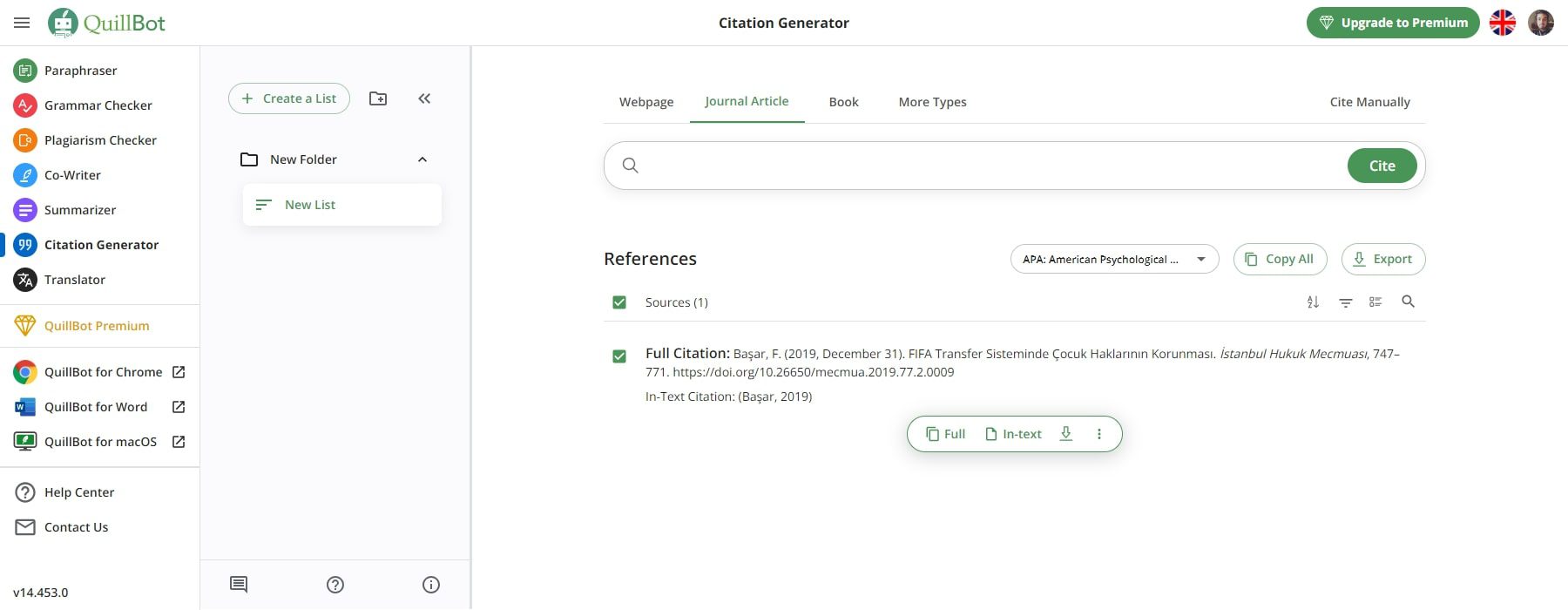
It supports common APA, MLA, and Chicago styles, covering reference types like books and websites. With an intuitive interface, it swiftly generates in-text and complete citations, labeled and exportable to Microsoft Word. By automating this process, QuillBot’s Citation Generator saves users time and ensures proper crediting of sources, benefiting those involved in research and academic writing projects.
5. QuillBot Plagiarism Checker
Quillbot AI provides a plagiarism checker, which is a premium feature. It eliminates the need for external tools to verify content originality. Premium users can paste their content into the checker, receiving results within minutes, indicating if the content is unique or plagiarized. Premium members can scan up to 20 pages per month with this tool, making it suitable for various types of content, including research papers.
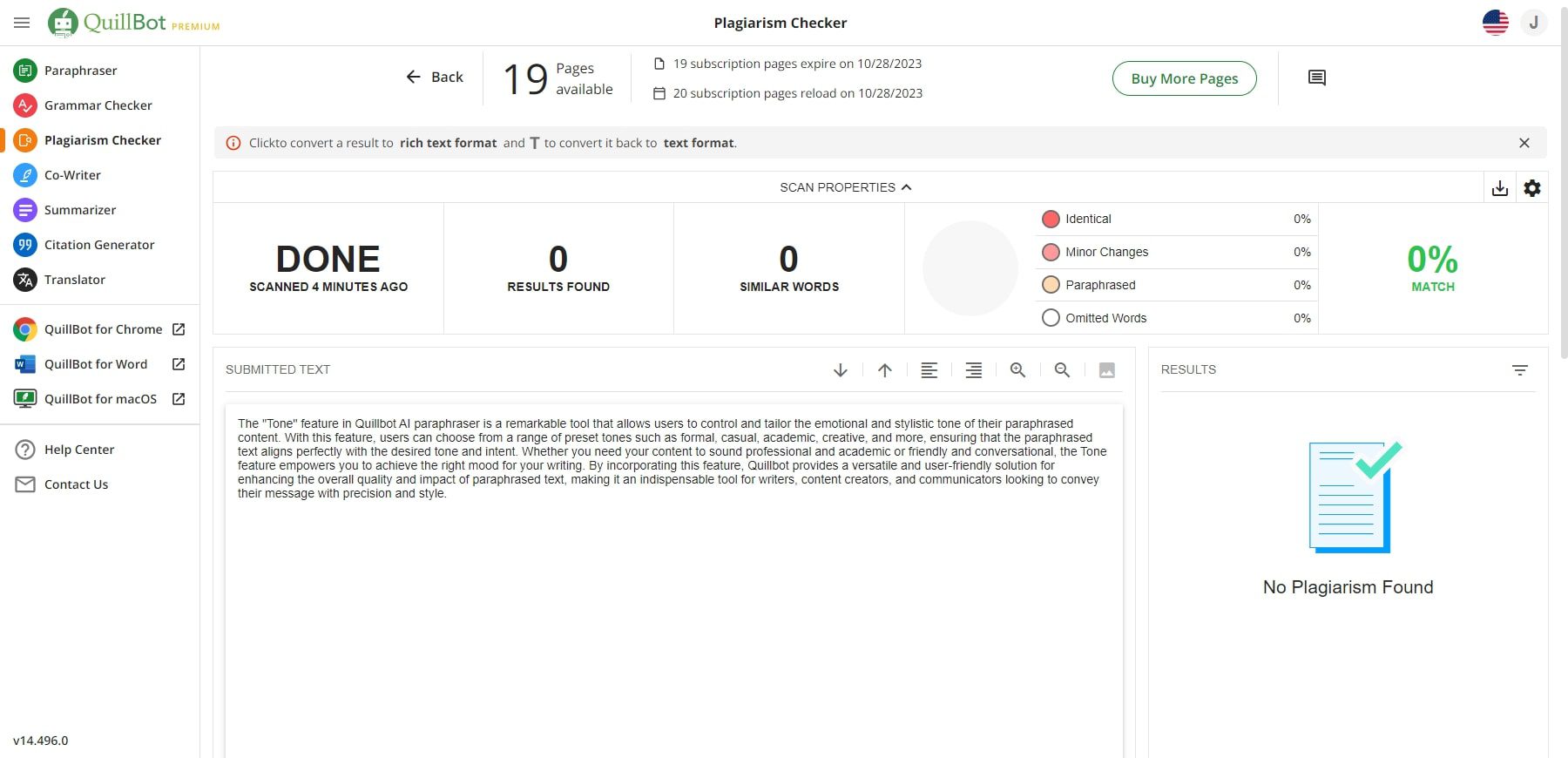
Its plagiarism checker stands out by accommodating research paper plagiarism checks, scanning up to 20 pages (approximately 5000 words) monthly. Consequently, it proves to be a valuable resource for essayists and academic writers, ensuring the integrity of their work.
Plagiarism detection is based on identical words , minor changes , paraphrased words , and omitted words .
6. The Translator
QuillBot AI provides its users with a Translation feature, allowing them to translate text into over 30 languages, making research and writing accessible across language barriers. It offers ad-free translation of up to 5,000 characters at once, includes integrated writing tools, and provides quick and accurate translations. The best part is that it’s free, enhancing convenience and accessibility for writers and researchers.
As a test, I added a block of content in the German language. The translator automatically detected it as German.
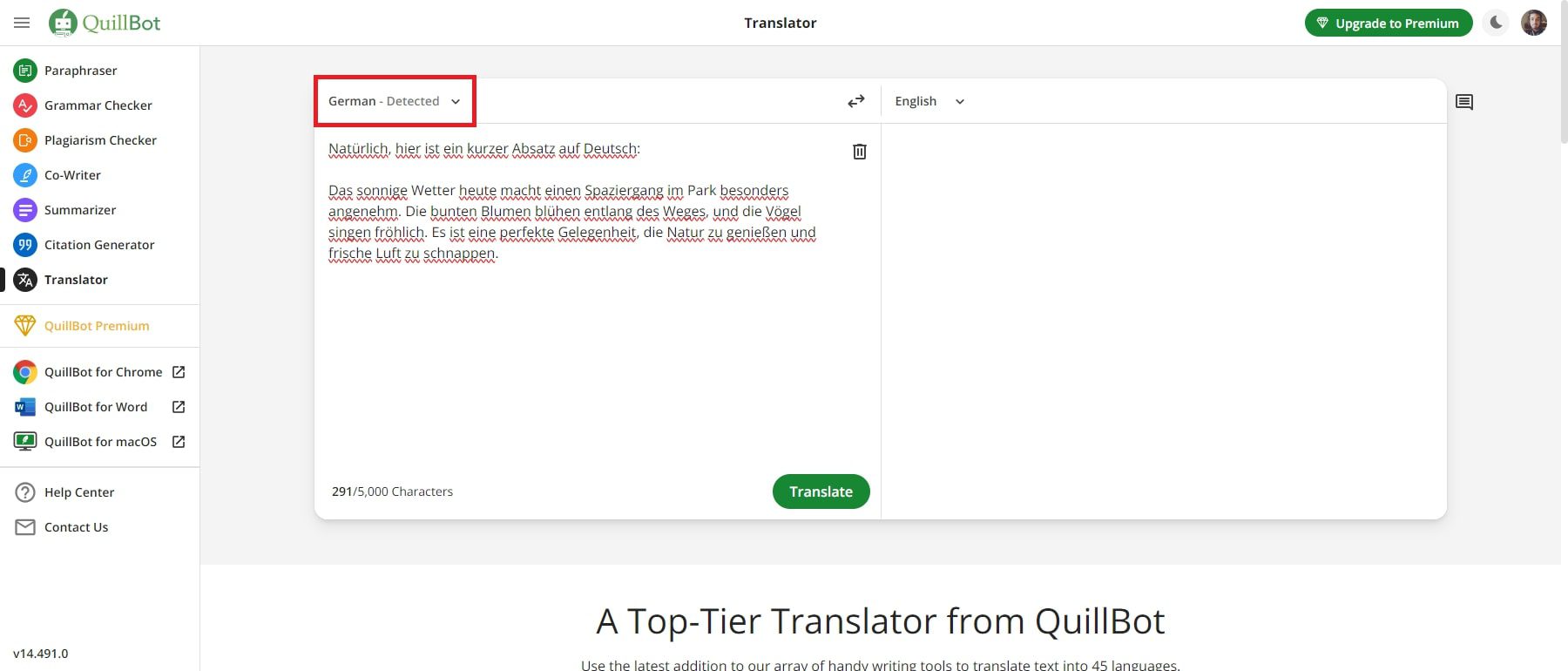
Then all you need to do is select the language you want it translated to on the right and click the Translate button.
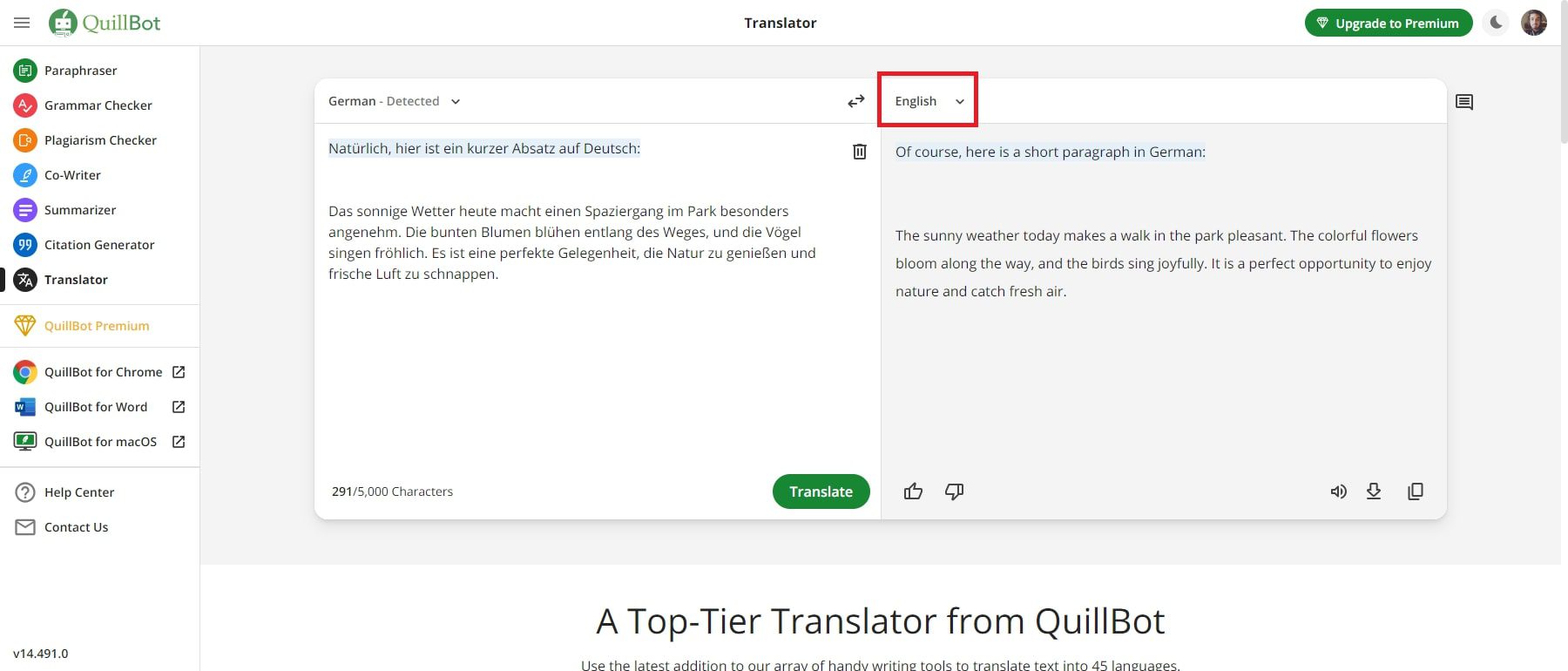
7. Quillbot Extensions
The tool offers three convenient extensions and applications to enhance your writing experience across different platforms.
QuillBot Chrome Extension
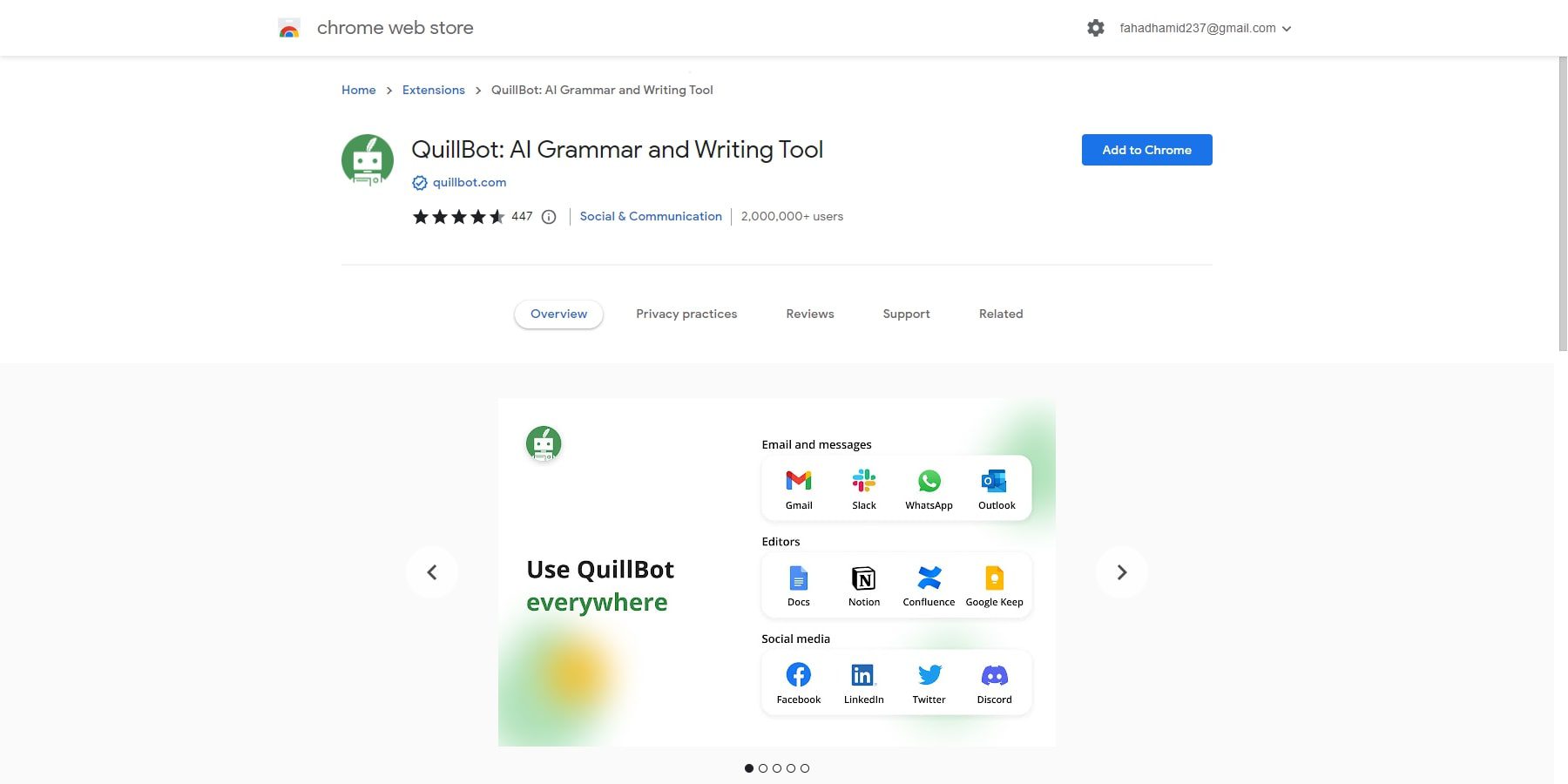
The QuillBot Google Chrome extension is a valuable tool for online writing. It seamlessly integrates with your web browsing, allowing you to check grammar, paraphrase, and summarize online documents (Google Docs), emails, and social media posts. Moreover, it ensures your writing is polished and error-free across the internet.
QuillBot for Word

If you’re working offline in Microsoft Word, this extension empowers you to access the full capabilities of QuillBot. It assists you in crafting high-quality documents, reports, and essays, ensuring your writing is clear and concise, even when you’re not connected to the internet.
QuillBot for macOS

For Mac users, QuillBot offers a browser-free desktop application. This standalone tool simplifies the writing process, providing a smooth and efficient writing experience on your macOS device. Moreover, it’s perfect for those who prefer a dedicated desktop application for their writing needs.
QuillBot AI Pricing and Plans Review

QuillBot AI provides three different pricing options to suit different needs and budgets.
The Basic (Free) Plan allows you to experiment with the tool before attaining its subscription. With it, you can paraphrase 125 words. It provides Standard and Fluency modes with limited use of the Synonym Slider. Moreover, you can summarize up to 1,200 words through the Summarizer mode.
The premium version of QuillBot AI allows unlimited words for the Parphraser, more writing style modes, and up to 6,000 words in the Summarizer. It also provides access to Plagiarism Checker, Paraphraser History, and Compare Modes.
You have the choice of three different payment plans for premium. The Annual Plan costs $8.33 monthly, with $99.95 billed every 12 months. The Semi-Annual Plan costs $13.33 monthly, with $79.95 billed every six months. The Monthly Plan costs $19.95 per month. By subscribing to either of these premium subscriptions, you can paraphrase unlimited words in Paraphraser. The Summarizer will allow you to summarize up to 6,000 words, and you can fully use the Synonym Slider.
Pros and Cons of QuillBot AI
As we delve deeper into our comprehensive review of QuillBot AI, it becomes imperative to assess the advantages and disadvantages of this sophisticated language processing tool. While this tool boasts various features and capabilities, no technology is without its strengths and weaknesses.
Pros of Using QuillBot AI
- A free plan is available, and there’s no need to sign up.
- There is a refund policy in place.
- Extensions for Microsoft Word, Google Chrome, and macOS are readily available.
- You can access a free Language Translator.
- The option to upgrade makes it very affordable to access additional features.
- An app for content summarization is available for free.
- Additionally, there is a free Grammar Checker app provided.
Cons of Using QuillBot AI
- Only two writing modes are available for free.
- OpenAI GPT AI writing is unavailable.
- There is no AI content detection feature.
- Manual intervention is usually required.
- Both free and paid plans have character limitations in place
How QuillBot Compares to Other Similar Tools
QuillBot AI offers valuable features for text enhancement, including effective paraphrasing and translation. Its free plan is a budget-friendly option, making it accessible to a broad audience. When compared to Grammarly , QuillBot outshines Grammarly’s ability to rephrase content. However, Quillbot’s grammar-checking capabilities fall short of Grammarly’s robust editing features.
Tools like Copy.ai and Rytr AI may offer more comprehensive solutions for advanced AI content generation than QuillBot. These alternatives excel in generating content from scratch, making them suitable for various writing needs.
Regarding accessibility, QuillBot stands out with extensions for Microsoft Word, Google Chrome, and macOS. This enhances its usability and integration into daily writing tasks. It also eliminates the language barrier, whereas Grammarly, Copy.ai, and Rytr AI primarily focus on English.
Ultimately, choosing these tools depends on your specific requirements and budget. QuillBot is a reliable option for text enhancement, while other tools may be better suited for advanced AI content generation and comprehensive grammar checking.
Should You Use QuillBot? (The Verdict)
QuillBot AI offers undeniable value as an AI writing assistant for various teams and individuals. Need an alternative version of your original article? QuillBot can generate a new and improved version swiftly. It is handy for optimizing blog posts and other content, outperforming many free and paid AI rewriter tools . Its ability to paraphrase content significantly reduces plagiarism risks for academic assignments and research papers. Although some detectors, like Originality.ai , may still recognize QuillBot paraphrased content in some cases. No AI content generator is 100% human. That said, thanks to its versatility and proficiency, QuillBot is a worthwhile asset for writers, students, and content creators.
Looking for more? Check out our list of top AI writing tools . And for all aspiring writers, check out these AI story generators . You can also explore more of the best overall AI tools you can use to boost your productivity in various ways .
Frequently Asked Questions (FAQs)
Here are some common questions that may help you decide if QuillBot is right for you.
What is QuillBot?
Can quillbot be detected, how much does quillbot premium cost, how can quillbot be used as a paraphrasing tool, how can quillbot be used as a summarizer.

Get Started With QuillBot AI!
Explore plans, pricing and features. Click here to get started. 👇
Explore plans, pricing and features here. 👇
By fahad hamid.
Fahad enjoys writing about a diverse range of topics, from business and marketing to design. Alongside this, he balances his love for tennis, showing skill both on the page and on the court.
Explore Divi, The Most Popular WordPress Theme In The World And The Ultimate Page Builder

Check Out These Related Posts

- How to Start a Web Design Business (2024 Guide)
Posted on June 30, 2024 in Business
The internet has exploded in the last decade, and more businesses are establishing online presence than ever before. With online competition at an all-time high, a well-designed website is no longer a luxury – it’s a necessity. This surge in demand for high-quality websites creates a...

6 Easiest Website Builders for Beginners in 2024 (Compared)
Posted on June 27, 2024 in Business
These days, having an online presence is a must. Without a website, you might as well be invisible on the internet. But if you’re not tech-savvy, the thought of creating and designing a website can be pretty intimidating. CSS, HTML, and coding can seem like a foreign language. You’ve...

Divi vs. GeneratePress: Which WordPress Theme Wins in 2024?
Posted on June 26, 2024 in WordPress
As website owners and developers strive to create visually appealing and high-performing websites, two themes have become prominent: Divi and GeneratePress. These themes offer top-notch features and customization options. This post compares Divi vs. GeneratePress in a head-to-head battle of two of...
Where did you get that annual price? I would love to get it. When I visited the site the price was twice as much ($99.95) if I paid the full year in advance.
Hi, Carlos. The pricing must have changed since writing the post. I have updated the article. Thanks for bringing it to our attention.
Carlos – for me, it’s showing as: USD Annual Save 58% $4.17 USD per month $49.95 billed every 12 months
Leave A Reply Cancel reply
- Recent Posts
- Introducing Divi Quick Sites & AI Website Creation
- Get a Free Realty Layout Pack For Divi
- How to Customize WordPress in 2024 (No Coding Required)
- Download a Free Sustainable Energy Theme Builder Pack for Divi
- Divi Resources
- Theme Releases
- Tips & Tricks
974,872 Customers Are Already Building Amazing Websites With Divi. Join The Most Empowered WordPress Community On The Web
We offer a 30 Day Money Back Guarantee, so joining is Risk-Free!
Divi Features
- All Features Explore Divi
- Divi Modules
- Divi Layouts
- Quick Sites Brand New!
- No-Code Builder
- Ecommerce Websites
- Theme Builder
- Marketing Platform
- Speed & Performance
- Premium Support
- Divi Marketplace
- Divi Hosting
- Extra Theme
- Bloom Plugin
- Monarch Plugin
- Plans & Pricing Get Divi Today
- Documentation
- Help Articles & FAQ
- 24/7 Support
- Developer Docs
- System Status
- Product Updates
- Best Plugins
- Best Hosting
- Divi Meetups
- Divi Facebook Group
- Divi Examples
- Divi Integrations
- Divi Reviews
- Community Forum
- Affiliate Program
- Terms of Service
- Privacy Policy
Copyright © 2024 Elegant Themes ®

IMAGES
VIDEO
COMMENTS
Paraphrasing allows you to summarize and synthesize information from one or more sources, focus on significant information, and compare and contrast relevant details. Published authors paraphrase their sources most of the time, rather than directly quoting the sources; student authors should emulate this practice by paraphrasing more than ...
APA guidelines, however, do encourage including a page range for a summary or paraphrase when it will help the reader find the information in a longer work. According to Jones (1998), APA style is a difficult citation format for first-time learners.
Parenthetical citation. For an APA parenthetical citation, write your paraphrase and then add the author and year in parenthesis at the end. Use a comma between the author and the year inside the parenthesis, and put the period for the end of the sentence outside the parenthesis. Example 1: Oh, say can you see by the dawn's early light.
Activity 1: Paraphrasing One Sentence. This activity consists of three steps: Read the following published sentence and then paraphrase it—that is, rewrite it in your own words. You do not need to repeat every element. Instead, try changing the focus of the sentence while preserving the meaning of the original.
Let's look at these examples if they were written in text: An example with 1 author: Parenthetical citation: Following American Psychological Association (APA) style guidelines will help you to cultivate your own unique academic voice as an expert in your field (Forbes, 2020). Narrative citation: Forbes (2020) shared that by following American Psychological Association (APA) guidelines ...
6 Steps to Effective Paraphrasing. Reread the original passage until you understand its full meaning. Set the original aside, and write your paraphrase on a note card. Jot down a few words below your paraphrase to remind you later how you envision using this material. At the top of the note card, write a key word or phrase to indicate the ...
APA 7 notes that "published authors paraphrase their sources most of the time, rather than directly quoting" (p. 269). • For writing in psychology, students should use direct quotations only sparingly and instead mainly synthesize and paraphrase. • When citing a paraphrase, you may include a page number, when it would help
Quoting is copying a selection from someone else's work, phrasing it exactly as it was originally written. When quoting place quotation marks (" ") around the selected passage to show where the quote begins and where it ends. Make sure to include an in-text citation. Paraphrasing is used to show that you understand what the author wrote.
Paraphrasing. When you write information from a source in your own words, cite the source by adding an in-text citation at the end of the paraphrased portion as follows: Mother-infant attachment became a leading topic of developmental research following the publication of John Bowlby's studies (Hunt, 1993). Note: If you refer to the author's ...
When you write information from a source in your own words, cite the source by adding an in-text citation at the end of the paraphrased portion as follows: Mother-infant attachment became a leading topic of developmental research following the publication of John Bowlby's studies (Hunt, 1993).
Paraphrasing. To paraphrase is to communicate the author's work in your own words and to acknowledge the source: Used to rewrite text in your own words. Used to clarify meaning. Used to shorten a longer statement, but keep the main ideas. Giving credit to the original author of the idea.
A paraphrase restates someone else's words in a new way. For example, you might put a sentence into your own words, or you might summarize what another author or set of authors found. When you include a paraphrase in a paper, you are required to include only the author and date in the citation.
APA Style: Basics; Citations for Paraphrased Sources; Search this Guide Search. APA Style: Basics. This guide is intended to help you cite sources in APA style, avoid plagiarism, learn what APA style is and includes, find examples of APA style, lead you to campus resources that can help you cite sources in APA, and more. ...
Citing in APA. This is what an APA citation looks like. In-text citation: Parents should be concerned about online advertising. These advertisers are manipulative, and children are more vulnerable than most parents expect (Cornish, 2014, p. 454). References page:
As the Publication Manual notes, citing your sources is imperative: "Whether paraphrasing, quoting an author directly, or describing an idea that influenced your work, you must credit the source" (p. 170). But, we are sometimes asked how a writer can properly and clearly attribute multiple ideas within a paragraph yet maintain a readable ...
To paraphrase effectively in APA style, read and understand the original text, then express the ideas in your own words while retaining the original meaning. Always provide an in-text citation with the author's last name and publication year, even when paraphrasing.
Paraphrasing: To restate an idea in your own words. APA Style prefers that authors paraphrase ideas from sources rather than directly quoting from them. Paraphrasing allows you to connect the ideas in a source to the ideas in your paper more clearly and succinctly. It cuts down on wordiness and demonstrates your understanding of the source itself.
Include signal phrases and an in-text citation to show where the quote is from. Paraphrasing Sources: When you paraphrase a source, you restate the source's ideas in your own words and sentence structure. Select what is relevant to your topic, and restate only that. Changing only a few words is not sufficient in paraphrasing/ summarizing.
In APA format, the information in a parenthetical citation is the author's last name, a comma, and the year of publication. If the author's last name and the date were given at the beginning of the paraphrase, they do not have to be repeated at the end. A page number is optional for a paraphrase, but it is a good idea.
When paraphrasing a passage, it is essential to express the ideas of the author in your own original words; however, the author's message and meaning should always be preserved. Charges of plagiarism can be avoided by including the proper citation of the work you are drawing from in your paraphrase. The APA requires a paraphrase to include ...
APA guidelines, however, do encourage including a page range for a summary or paraphrase when it will help the reader find the information in a longer work. Regardless of how they are referenced, all sources that are cited in the text must appear in the reference list at the end of the paper.
An APA citation generator is a software tool that will automatically format academic citations in the American Psychological Association (APA) style. It will usually request vital details about a source -- like the authors, title, and publish date -- and will output these details with the correct punctuation and layout required by the official ...
Here is a quick overview of the difference between quoting, paraphrasing and summarizing: QUOTING. What it is: Using the exact words of your source; must be placed within quotation marks. When to use it: Specific terminology, powerful phrases. Example: McMillan Cottom (2021) explains that "Reading around a subject is about going beyond the ...
Follow APA's guidelines for paraphrasing and direct quotations. Reference List. When compiling your list of references, ... APA Style tailors entries based on the type of source you are citing. See the APA Guide for examples of citations for books, book chapters, ebooks, the DSM manual, articles, web content, test instruments, data, ...
Citing Sources in APA, 7th Edition. University Libraries. Posted by Angela Brcka for University Libraries Join Kate Langan, WMU Humanities librarian, for this workshop on how to use the Publication Manual of the American Psychological Association (APA) for citing sources. Kate will review: Why we cite. Difference between paraphrasing and quoting.
CITING A SOURCE The main types of citations are direct quotes, paraphrases, and summaries. How to include a direct quote - a direct quote is words that are copied exactly from another writer's work. The following information is required for a direct quote: Author's surname; date the source was published; page number (p.1).
Paraphrasing and Summarising ; Reference List Toggle Dropdown. Examples of References in Harvard style ; Quick A-Z Examples of References ; ... PDFs, and 30 other sources in over 9,000 different citation styles, including APA 7, Chicago, Harvard and MLA 9. This includes the Cite them Right 12 th edition Harvard style which ATU library supports.
Yes. There is a chance that QuillBot-generated content can be detected as AI. There are several AI Content Detectors available for this purpose. Plagiarism and AI detectors like Originality.AI and Turnitin have developed innovative AI to identify content that QuillBot or similar AI writing tools have altered. These detectors have been trained extensively to recognize AI paraphrased content ...